| |

Eastern Christians cling to their faith as time runs out on the former coal towns of Pennsylvania, reports Jacqueline Ruyak with photographs by Cody Christopulos
Reprinted here with Permission of
CNEWA
Eastern Christians cling to their faith as time runs out on the former coal towns of Pennsylvania, reports Jacqueline Ruyak with photographs by Cody Christopulos
Reprinted here with Permission of
CNEWA
It is the eve of Theophany at St. Mary Protector Byzantine Catholic Church in the northeastern Pennsylvania town of Kingston. Masses of red and white poinsettias frame the iconostasis; the fragrance of beeswax tapers and votive candles fills the air. Father Theodore Krepp celebrates the blessing of water, a purification rite of profound meaning and quiet drama marking the feast of the baptism of Christ. Afterward a hushed congregation lines up to fill bottles with the holy water. “High test stuff,” says an elderly parishioner.
Eastern churches dominate the cityscape of Kingston.
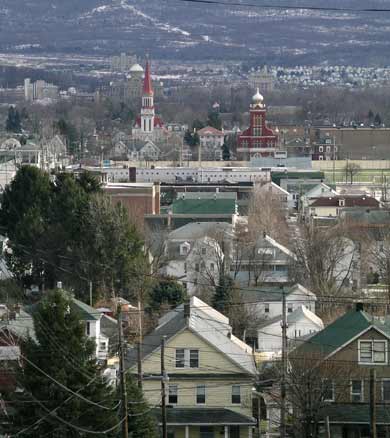
Few of the 100 or so in attendance are children or, for that matter, young. When Father Krepp arrived at St. Mary’s eight years ago, the church had about 275 families. It now has 250, but only 50 children. He points, in contrast, to St. Anne Byzantine Catholic Church in Harrisburg, which was founded in the 1960’s in part because of migration from towns like Kingston; it now has about the same number of families, but three times the number of children. Simply put, demographics indicate that all churches in the region are losing people. With few opportunities locally, almost all the young have left.
Northeastern Pennsylvania at one time contained three-quarters of the world’s anthracite deposits. The 18th-century discovery of the hard coal – formed over 250 million years ago – later sparked a mining frenzy that would fuel the industrialization of the United States, spur revolutions in technology and create boom towns across the region. Desperate for workers, mining companies scoured Central and Eastern Europe for cheap labor, recruiting many agricultural workers eager to escape the turmoil and poverty of their homeland.
Shenandoah, which sits on the Mammoth coal vein, is home to the gold-domed St. Michaels – the first Ukrainian Greek Catholic Church in the United States.
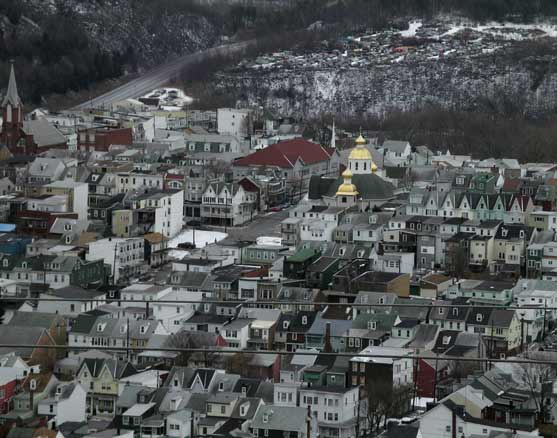
The immigrants saw opportunity in the dirty, dangerous jobs in the mines. Devoted to their families and churches, these hard-working people shaped the resilient character of the coal region.
But as the country’s energy consumption shifted toward cleaner fossil fuels and the once massive deposits of coal became depleted, the mines began to close. By the late 1950’s, only a few were left, devastating the region’s once vibrant economy and leaving miners without jobs or the skills to compete in a changing labor market.
Garment, shoe and textile factories provided some economic hope in the 1960’s and 1970’s, but they could not compete with rivals in the South and abroad. Consequently, many were forced to leave the region to find jobs. Coal made many towns and for almost a century they thrived, but the closing of the mines sent these towns into a spiraling decline, from which they have never recovered.
One of the oldest Eastern Catholic churches in the United States, St. Mary’s was founded in 1887 to serve Ruthenians. Peasants from the Austro-Hungarian Empire, they came from the Carpathian Mountains, a hardscrabble region now divided among the modern states of Slovakia, Poland and Ukraine. Like many Austro-Hungarians, these people did not have a clear sense of ethnic identity. Their faith, Catholic or Orthodox, set them apart from their neighbors.
Tradition and family, says Father Krepp, have always been central. “Our primary goal, beyond serving the existing population, is to instill the identity of being an Eastern Christian, a Byzantine Catholic, into our youth so they can take it with them when they leave their families. Once that identity was a given. When the church was the center of life, you didn’t have to know a lot about it; it just was. Now if you don’t know what your religious faith is and understand why it is important, it’s just lost when you leave.”
A week after Theophany, Father Krepp is conducting a round of house blessings in the neighborhood. John and Mary Ann Evans share a converted duplex with Mrs. Evans’s 93-year-old mother. A retired social worker, Mr. Evans takes care of his mother-in-law while Mrs. Evans works in their son’s office. Their three children and their grandchildren remain in the area.
Married 50 years, the couple met in the church choir as did many of their friends. From choir and catechism class to caroling and socials, says Mrs. Evans, everything then was “church-involved.”
TV and computers, they agree, have changed life. “You always looked forward to church on Sunday,” says Mr. Evans, “but now everybody seems to have things that are more important.” He worries that, because so many people have left for jobs elsewhere, there are few young adults to assume responsibilities in the church.
Further down the block, Mary Yasenchak, 80, lives next door to her widowed daughter, Mary Ann Mehm. Of Ukrainian background, Mrs. Yasenchak married into the church, while her daughter married out of it only to return after losing her husband in 1996. “It was like I came home because everyone I knew growing up was still there. And they all welcomed me back. It’s like I never left.”
Mrs. Mehm is speaking, however, of her mother’s generation. Most of Mrs. Mehm’s contemporaries have left the area. Of her three children, the youngest is still at home, another remains in the area and the third lives in Brooklyn.
When conversation turns to feast day picnics and piroghi, halupki (stuffed cabbage) and other traditional foods, the two women drift into the kitchen. There spread across the table are homemade bread, kielbasa with horseradish and sweets – cookies and coffee cake, a congenial ending to a house blessing.
Located in the Wyoming Valley, both Kingston with 13,512 residents and neighboring Edwardsville with 4,984 now have declining populations and share a history of catastrophes. In 1959, the Knox mine disaster put an end to mining in the region; in 1972 Hurricane Agnes caused the Susquehanna River to flood, creating one of the most devastating natural disasters the country had ever seen.
Founded in 1911 to serve the then-growing Russian Orthodox community, St. John the Baptist Church is just two blocks from St. Mary’s, and across the tracks, in Edwardsville. Those immigrant Russians were, in fact, from the Carpathian Mountains and Galicia, in what is now Ukraine.
More than half of St. John’s 200 or so parishioners are over 60. To help keep his aging congregation involved, Father Michael Slovesko, called from semiretirement five years ago, is busy overseeing a $300,000 project to install restrooms, as well as an elevator, inside the church. The elevator, he says, will enable wheelchair-bound parishioners to attend church again; it will also make it easier to bring caskets in for funerals.
On a frigid January morning, several parishioners are gathered at the church. Wanda Wanko, 91, who embraced Orthodoxy in 1932, is the oldest; Eugene and Shirley Gingo, in their late 50’s, are the youngsters in the group. The Gingos are unusual in that all their children have opted to stay in the area.
All present remember how it was before people began to leave in large waves, when Edwardsville was a collection of ethnic neighborhoods, but where everyone knew everyone else.
People walked everywhere: to the mines, to visit cemeteries and to go caroling in the town and countryside. They bought their meats and vegetables, their candy and liquor at local stores. They danced and sang, ate and drank at local social clubs. They walked down Main Street, now a dispiriting stretch of marginalized businesses, and saw everyone. Now, those who are left shop at malls.
At the center of it all was the church. “There were a lot of good times that were held from this church,” says one parishioner. “The point is, if there’s no church, there’s no community.”
For the past five years St. John’s has held an annual ethnic food festival, which offers potato pancakes, piroghi, halupki, pigs’ feet, borscht and other favorites. The festival draws people from other churches – even politicians come. So do young people and children. “It’s really very popular,” says Ms. Wanko, “now that they know we have all this good food.”
Some 40 miles southwest of Kingston and Edwardsville lies the town of Shenandoah, which is situated along the Mammoth coal vein. Called the “most magnificent coal bed in the world,” this vein produced over two-thirds of the anthracite mined. Shenandoah was founded in 1866, four years after the first colliery opened, bringing in settlers, eating houses, saloons and more.
Other plants soon followed, and then banks, hotels, boarding houses and tenant houses. In time, three railroads ran into the town. Early settlers were Welsh, Irish and German. Later came the Poles, Ruthenians, Slovaks, Ukrainians, Lithuanians and Italians. Each group settled in their own neighborhoods and, once enough money was collected, each group built impressive churches that resembled the ones they left behind in the Old World. There was a bar on every corner for miners to stop in and “wash the dirt away.” Once the coal mines closed, most of the bars did, too.
In 1915, at its peak, Shenandoah had about 30,000 people. Ripley, in his famed “Believe It or Not” column, once called the town the most congested square mile in the United States. The population is now about 6,000; almost 70 percent are over 60 and 14 percent live below the poverty line.
All the hills surrounding the town have been mined. Massive banks of culm, the waste left after coal screening, are everywhere. Thanks, however, to three cogeneration plants, designed to clean the waste of whatever energy it contains, trees now grow here and there on the culm. In winter, at least, downtown is a disconcerting mix of shabby, sometimes boarded-up buildings and unexpected promise – a ghost perhaps of what used to be.
Seen from high above town, the golden domes of St. Michael Ukrainian Greek Catholic Church still draw the eye. Established in 1884, St. Michael’s is the first Ukrainian Greek Catholic church in the United States. The current church, dedicated in 1984, replaces the original, which was destroyed by fire in 1980. On a morning when the streets are slick with ice and the temperature dips below zero, there are only two women at church.
That afternoon Father Petro Zvarych from St. Michael’s is visiting with three of his parishioners: Nancy Sawka, a recent widow and former bakery owner in nearby Frackville; Andrea Pytak, a retired nurse who volunteers at the rectory; and Samuel Litwak, fresh from a meeting of Downtown Shenandoah Inc., a local group dedicated to the revitalization of downtown.
Mr. Litwak recalls when the main streets were “no different from Manhattan. Shops had the same quality of merchandise as in New York and people were shoulder to shoulder. It was just small town America, and that’s the way it was.”
He has childhood memories, too, of coming to church and not being able to get a seat. The parish now has about 150 families, including about 30 children. Says Ms. Pytak, “In the past three years, we have buried 112 parishioners, and there have been only two or three births a year.”
As in other coal towns, many people have left, while others commute many miles a day to work in Harrisburg, Allentown or Reading.
Father Zvarych, who hails from a small town in Ukraine not unlike Shenandoah, has been at St. Michael’s for less than two years. “It’s a small town, but somehow people are enjoying their lives. What’s nice about this area is that people actually live as a community. They go to church together, they share things together. Something happens and they come to each other, not like in a big town or city.”
Note: The records of Bitumen are held at the Lock Haven County Court House, St. Joseph's Catholic Church in Renovo, PA, and at St. Mary's Church in Lock Haven. Thanks goes to Teresa Kisko for providing this helpful tip for those researching ancestors from Bitumen.
by, John Martinyak
Courtesy of Robert Smith
Courtesy of Stephen Miller
Courtesy of Steven M. Osifchin
Courtesy of Teresa Kisko
Courtesy of Teresa Kisko
In Memory of the Tomko & the Ronger Families
Bitumen, Pennsylvania
by, John Martinyak
During the later part of the 1800's many people from Eastern Europe decided to immigrate. Many of these immigrants came seeking work and most times, they moved to areas that offered unlimited employment opportunities. This was the case for the town of Bitumen, Pennsylvania. During the years of 1894 to the early 1920's Slovaks came to this town for work, and a new life. It is interesting to scan census figures for this town as it was mostly populated by Slovaks outside of a some individuals of Swedish and Ruthenian heritage. The main attraction for this town was the Kettle Creek Coal Company. This mill offered vast employment opportunities for the new immigrants. Even though the work was dangerous and hard, the jobs were abundant and steady. Bitumen revolved totally around the Kettle Creek Coal Company. Residents lived in company owned homes and shopped in company owned stores as was the practice in some states, especially Pennsylvania and West Virginia. This company had the entire town in its control. If an individual wished to purchase goods from another town, or a Sears Catalog, the company would not permit the delivery of such items. The residents had no choices and were dependent upon local stores. Not only in commerce but also, there was a company doctor who cared for the residents. The review of historical documents shows one doctor was named Dr. Mervine and he treated not only the accident cases in the mines but took care of all other medical needs in the community. Payment of the doctor could take many forms as these immigrant residents had very little financially. Many residents of Bitumen had their own vegetable gardens and some small livestock and poultry. It was not uncommon for a resident to pay the doctor with a chicken, or a basket of tomatoes. These gardens also helped the immigrants to stretch their paychecks and help keep their bill at the company store lower.
After the immigrants had settled in Bitumen the need for a church became necessary. In 1897 with funding from The First Catholic Slovak Union (Jednota), Immaculate Conception Slovak Roman Church was built to serve the immigrants spiritual needs. The church was moved several times due to constant expansion of the Kettle Creek Coal Company to where it finally stands today. This church is a wooden, clap-board frame design and is similar to many un-adorned Protestant architectural churches in the region. This church also started a school for its children. Studies in grammar, mathematics and history were combined with religious instruction. The Vincentian Sisters of Charity were called upon to staff the school and teach its pupils. Classes in the Slovak language were also taught to the children as in town it was more common to hear Slovak than English in the shops and stores. Not only were Slovak Roman Catholics members of Immaculate Conception but also, those Slovaks (and some Ruthenians) of the Greek Catholic church attended services.
The cemetery that is located next to the church shows old grave stones which are not only Roman Catholic but also Greek Catholic (an Eastern Rite). These Greek Catholics can be identified by their distinct three bar crosses. As time progressed a local public school was added and this was beneficial to residents who could not afford the small tuition to the Catholic school. Bitumen grew as more and more immigrants came due to letters from their families telling them that jobs were available. The town started to take on an atmosphere such as that found in any remote Slovak village. People refrained from work on holy days and had processions in the streets. A band was organized which played on these days and for American holidays and celebrations. Dancing was also an important social function and the town would eventually build two dance halls which would sponsor various events for the public. Also constructed was a Slovak Hall which would be the seat of two Slovak fraternal organizations. Many people in Bitumen had limited financial resources and therefore, had to find forms of entertainment which had no financial requirements. Baseball games were very popular as were picnics and long walks after the Sunday meal.
During the period of World War I the town continued to expand. When America entered the war in Europe many companies in the United States decided to cut their workers salaries. The Kettle Creek Coal Company also implemented this practice. Many of the workers saw their salaries cut while doing the same long hours of work. This practice was to cause much dissent in Bitumen and in other towns and cities throughout the United States. Many immigrant males decided to join the service rather than work for less wages. Joining the service also offered one advantage which they did not have in their home towns. It would offer them an easier way to become American citizens and many joined voluntarily throughout the United States. In Bitumen, the Slovak immigrants banded together and refused to take a cut in their salaries. Being a union mine, the company let their contract expire and then refused to open again. The miners then went on strike and the company brought in new workers to staff the mine. These were times filled with tension as war fever had become prevalent in the United States. Striking was seen as un-American and at its worst, treason. Many striking miners were evicted from their company owned homes and this was a great hardship for many. Company and local police constantly patrolled not only the Kettle Creek Coal Company property but, the town itself as they felt they not only owned the mine, but, the town as well. As the strike progressed and people lost their homes, many decided to leave Bitumen. Relocating was common to other cities and towns where relatives lived or where friends told them of employment opportunities. One place which many residents migrated to was Trenton, New Jersey. Trenton at this time offered many benefits over Bitumen, the best being New Jersey had outlawed the company store and home practices soon after the turn of the century. Trenton’s employment base was expanding due to its region. Mines and mills of coal or other based fuel products were not the main base in New Jersey. The manufacturing and production of goods and textiles was always needed and Trenton had large abundance of these companies.
When the strike finally ended many saw no reason to stay in Bitumen. The company had won the day and many families had suffered terribly. When the Kettle Creek Coal Company opened again for full production, many refused to return to their jobs which now had their salaries set at a lower rate. This was the beginning of the demise of Bitumen. As each month came and went, more and more families packed their belongings and compiled their financial resources to leave. The church was a good indication of the numbers who left as the membership began to decline very seriously. The parochial school which had been started at Immaculate Conception Slovak Roman Catholic Church had to be closed. With few students to teach the Vincentian Sisters of Charity left as they were not needed any longer. More and more individuals left Bitumen as word came back from former neighbors of the opportunities in other states and towns. The membership of the church fell so low that it was finally made a mission church for Saint Joseph’s church in nearby Renovo. Things became so desperate that it was suggested the church be dismantled. The few remaining members of Immaculate Conception in Bitumen banded together and petitioned the Altoona-Johnstown Roman Catholic Diocese not to do this. By 1969, the members of the church and new residents of Bitumen continued to ask the Diocese to keep the church open. They wished to preserve the church as it was not only a house of worship, but, a historical part of Bitumen and turn of the century immigration. It was decided to turn the church into a shrine and residents and members began the Bitumen Shrine Corporation to protect and maintain the church and cemetery. Collections and donations were received and the church was renovated. Today, this church is totally dependent upon donations for its upkeep and maintenance.
Not only those from Bitumen but others have given of their time and talents to keep this church maintained and functioning. An individual from Renovo took an entire summer by himself and restored the crucifix in the church yard. Many other residents of Bitumen have continued to support and maintain the grounds and church structure. During each Fourth of July weekend there is a reunion held in Bitumen at Immaculate Conception Shrine. Former residents, present residents, friends and supporters gather at this Shrine to see each other and participate in a mass. It is to the credit of the present day residents of Bitumen and all those who are helping to preserve this piece of immigrant history. This small, white clap-board church is a historical delight and one of the very few glimpses into the immigrant experience. The cemetery is also an historians pleasure as many of the stones are very old and have great ethnic historical value. The cemetery, being right along side of the church reminds a person of the villages in Eastern Europe where this practice is seen. It is very uncommon today to find a church which has a cemetery attached to it and especially, one that was begun and almost totally filled with one particular ethnic heritage. Inside the church, the altar is graced by statues of SS. Cyril and Methodius which are honored saints by the Slovak people. This church has seen history in the making and its members labored hard to build and support it. It is a monument to the founders of Immaculate Conception and also to the residents who helped build the town of Bitumen. For those who travel in this area of Pennsylvania, this town is not to be missed as the experience will make a deep impression on the visitor for a very long time.
Courtesy of Robert Smith
Bitumen miners sitting on a "mantrip". The second man from the left John Ronges (Rondos, Ronyges, Ronges, Rongers) Robert's Grandfather
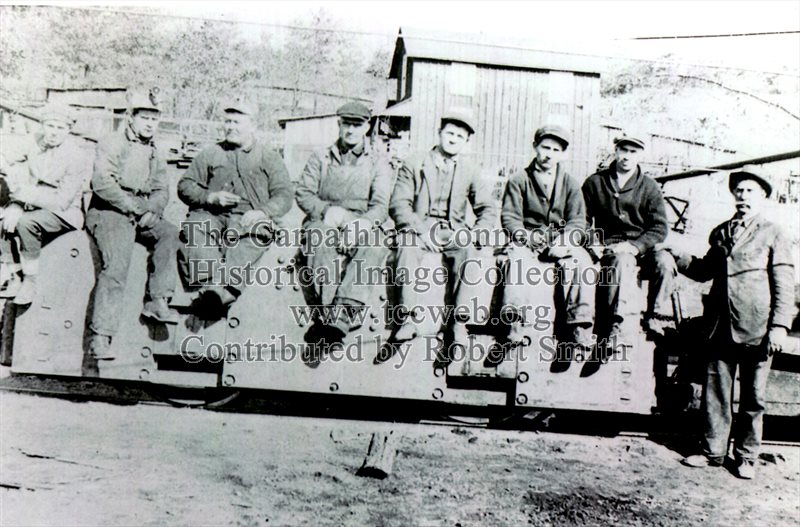
Photos Courtesy of Steven M. Osifchin
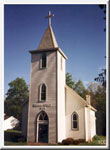
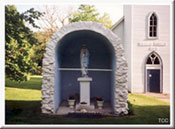
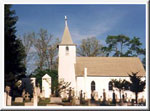
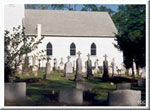
Courtesy of Teresa Kisko
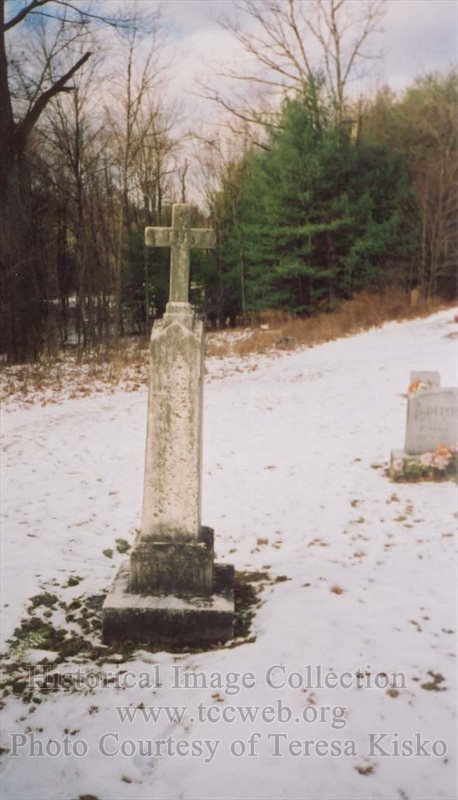 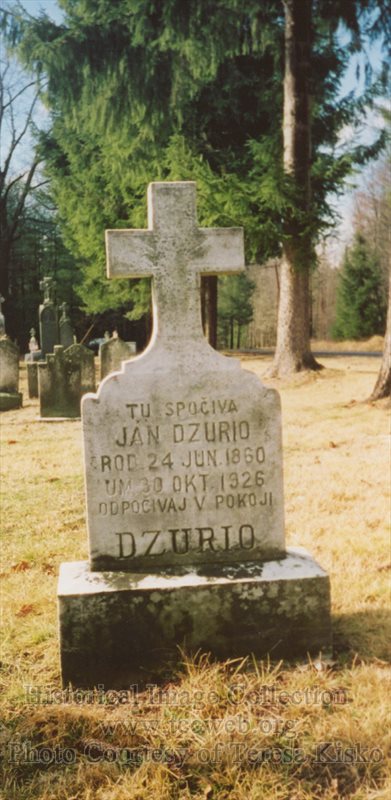
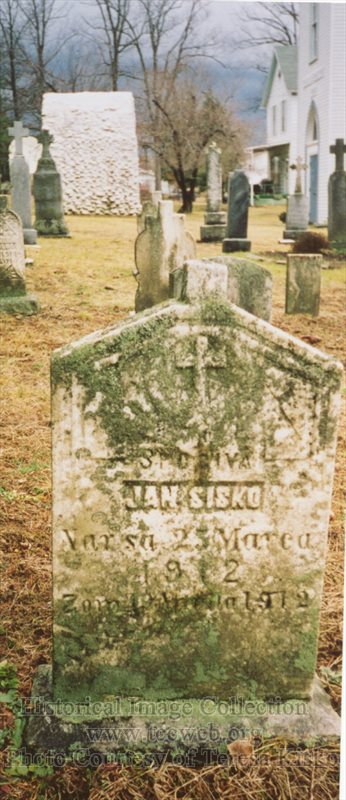 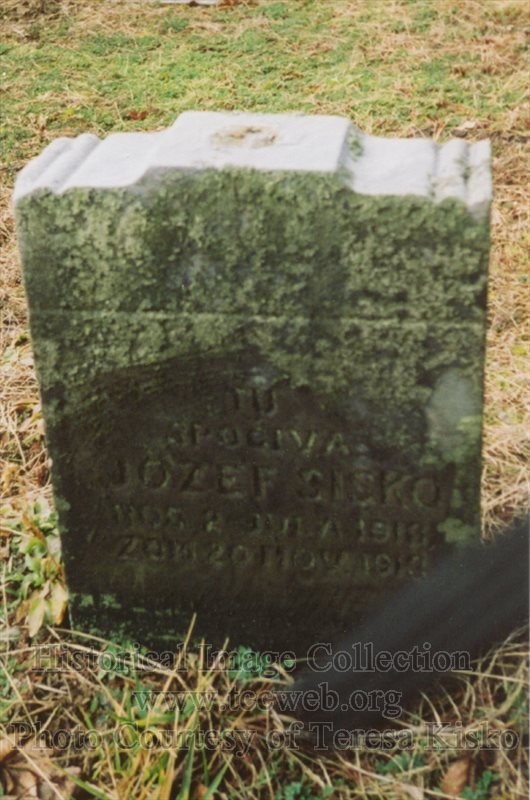
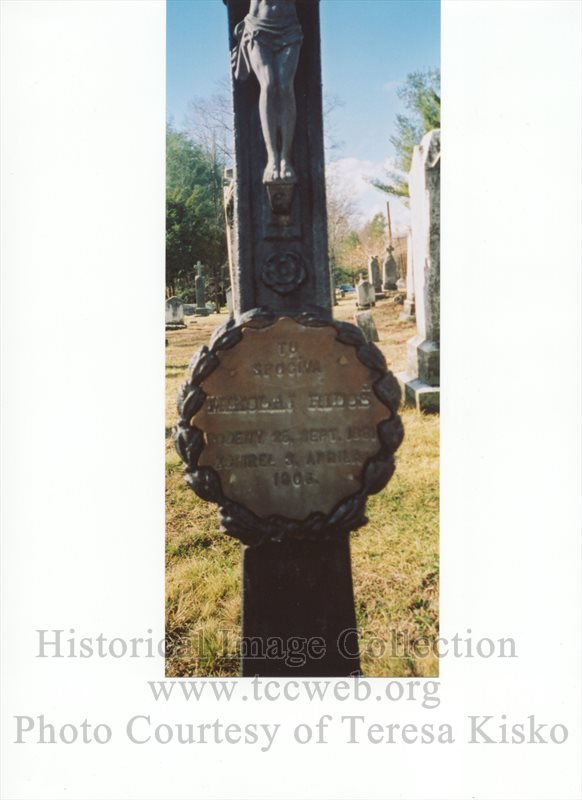
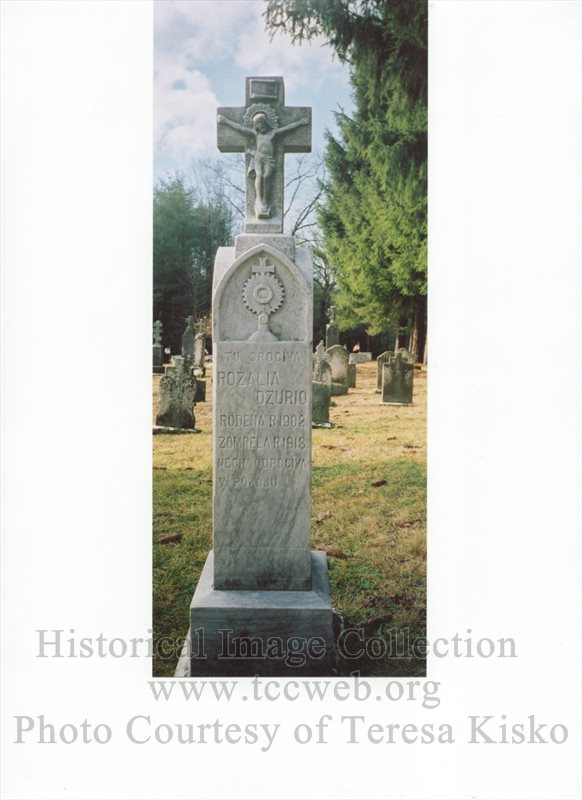
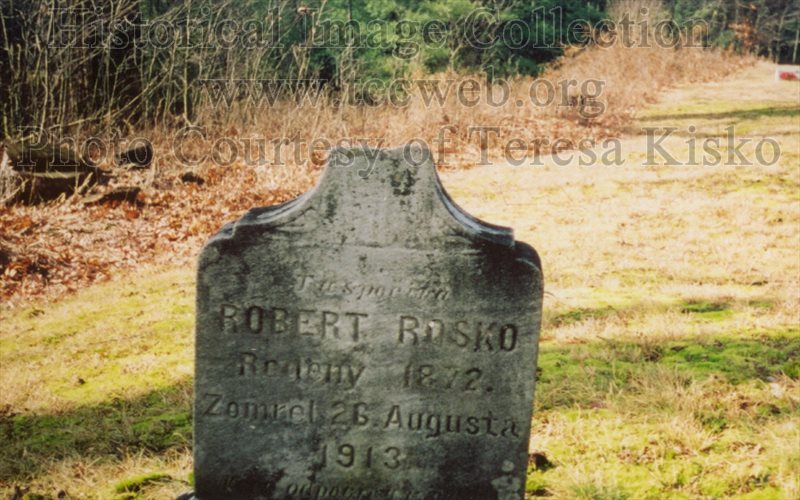
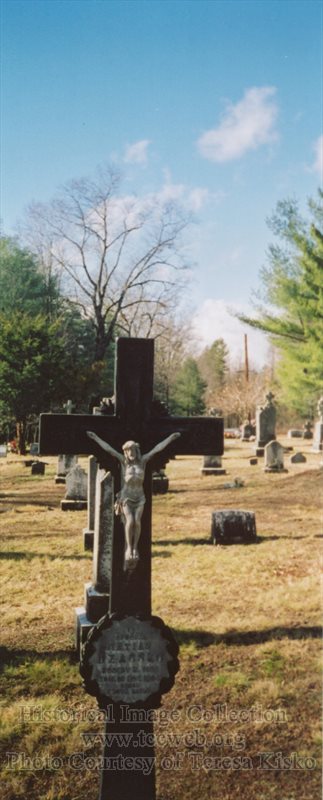 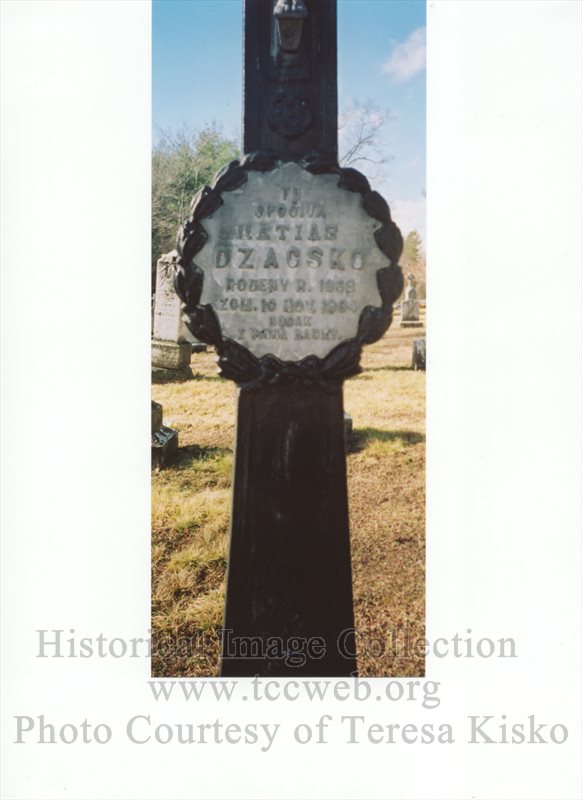
Courtesy of Teresa Kisko
Dedication Plaque Located in the Church Entry
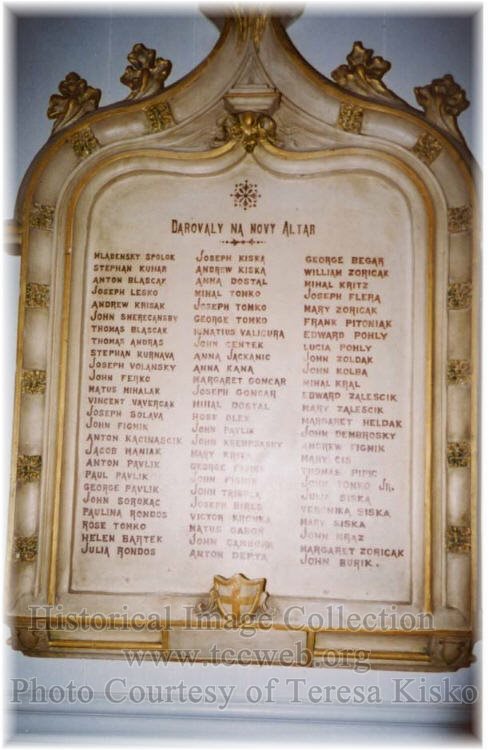
Names found on Plaque
-
Mladensky Spolok
-
Stephan Kunar
-
Anton Blascaf
-
Joseph Lesko
-
Andrew Krisak
-
John Smerecansky
-
Thomas Blascak
-
Thomas Andras
-
Stephan Kurnava
-
Joseph Volansky
-
John Ferko
-
Matus Mihalak
-
Vincent Vavercak
-
Joseph Solava
-
John Fichik
-
Anton Kacinascik
-
Jacob Maniak
-
Anton Pavlik
-
Paul Pavlik
-
George Pavlik
-
John Sorokac
-
Paulina Rondos
-
Rose Tonko
-
Helen Bartek
-
Julia Rondos
-
Joseph Kiska
-
Andrew Kiska
-
Anna Dostal
-
Mihal Tomko
-
Joseph Tomko
-
George Tomko
-
Rinatius Valicura
-
John Centek
-
Anna Jackanic
-
Anna Kana
-
Margaret Concar
-
Joseph Concar
-
Mihal Dostal
-
Host Olex
-
John Pavlik
-
John Kelmpsasky
-
Mary Kritz
-
George Figmik
-
John Figmik
-
John Trivula
-
Joseph Bires
-
Victor Kromka
-
Natus Gabor
-
John Cambora
-
Anton Depya
-
George Begar
-
William Zoricak
-
Mihal Kritz
-
Joseph Flera
-
Mary Zoricak
-
Frank Pitoniak
-
Edward Pohly
-
Lucia Pohly
-
John Zoldak
-
John Kolba
-
Mihal Kral
-
Edward Zalecsik
-
Mary Zalecsik
-
Margaret Heldak
-
John Dembrosky
-
Andrew Fignik
-
Mary Cis
-
Thomas Pipic
-
John Tomko, Jr.
-
John Siska
-
Veronika Siska
-
Mary Siska
-
John Mraz
-
Margaret Zoricak
-
John Burik
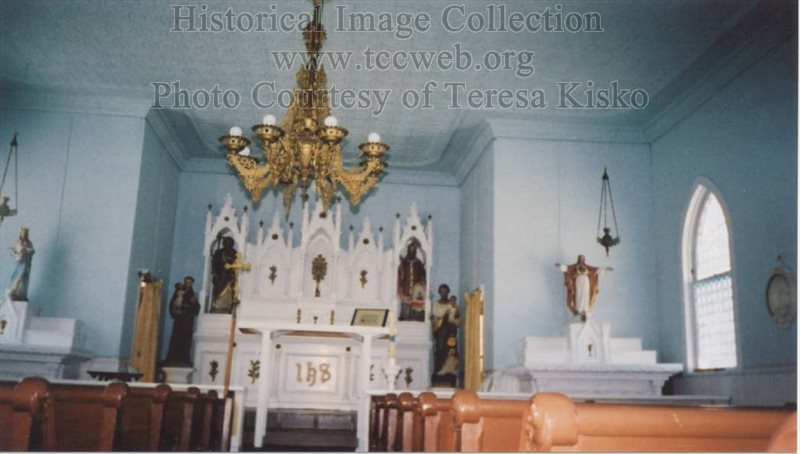
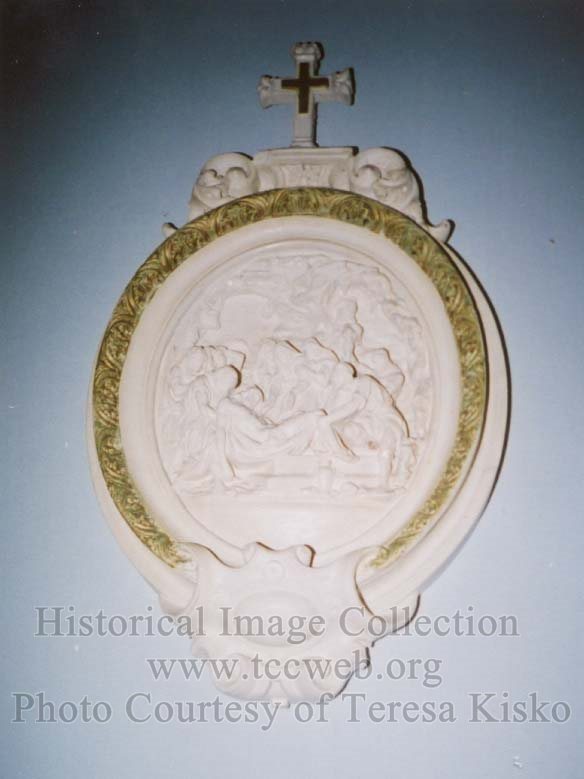
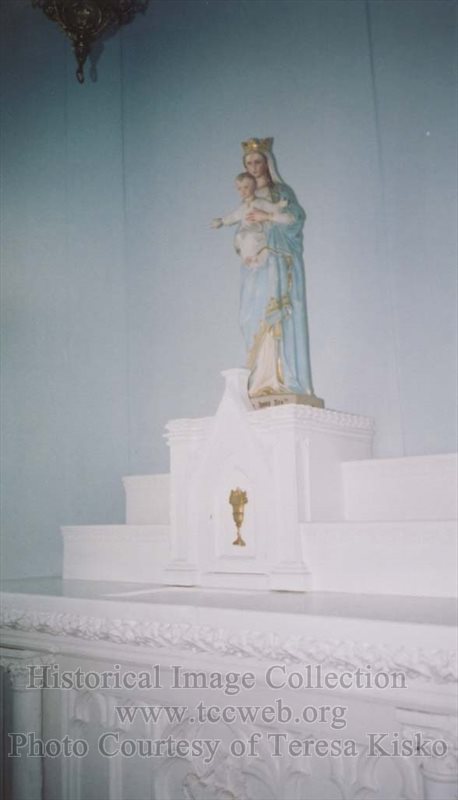 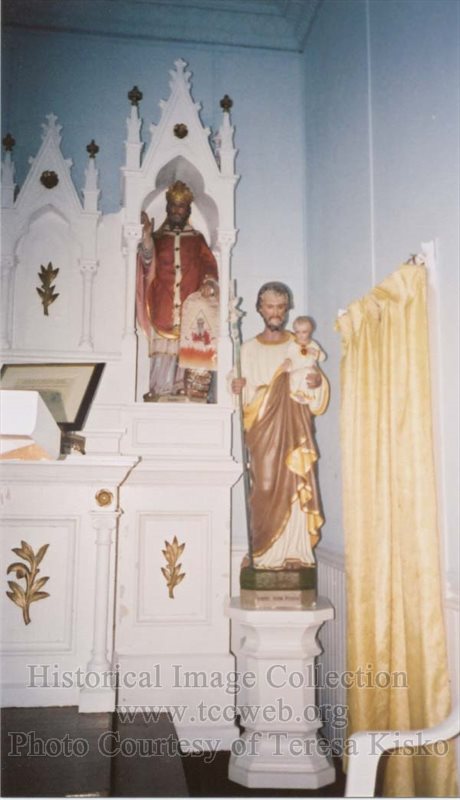
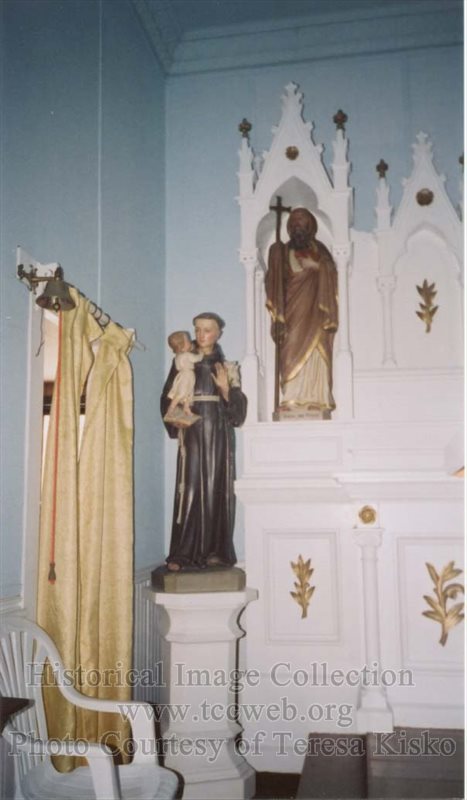
In Memory of the Tomko & the Ronger Families
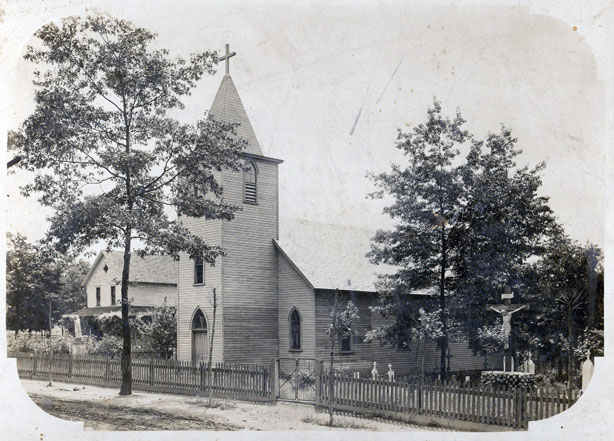
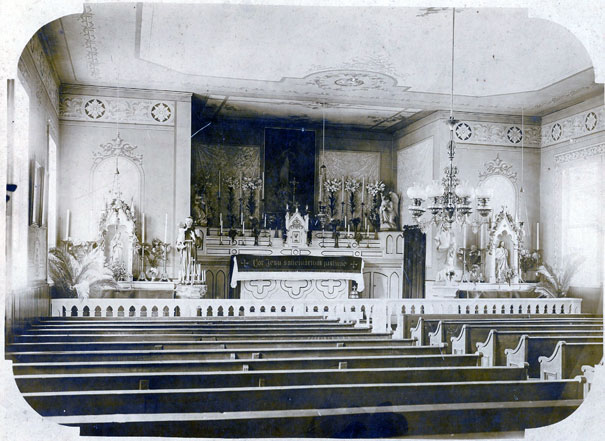
Swanson & Anderson Photographers, Bitumen, PA.
Searching for information on Jan Nadaský. He was an Uncle on my Mother's side. He left Nagy Brestovany (now Velke Brestovany) Slovakia in former Nitra County today Trnava County in summer of 1912 and lived in Bitumen, Penna. In March 1913 his leg was broken in a mine accident and he stayed with out a job. The last letter our family received from him was in April 1913. He was asking for money for his return trip home. In June 1913 our family sent money to him at Box 117, Bitumen, PA, Clinton County, USA. This information was garnered from two old letters and an old money order confirmation. The family never heard from him after that last letter. Jan may have had a cousin living in Penna named Joseph Turansky. This is a photo from right to left of his wife Agnesa, son Stefan, and son's wife Agnesa sometime in the 1950's. Thank you, Mario Veneni.
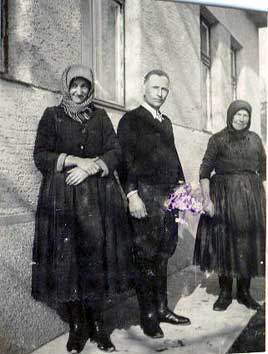
Contact: Mario Veneni
Compiled Listing of Slovak Immigrant Surnames
Courtesy of John C. Orsulak
Compiled List of Marriages 1882 - 1903
Courtesy of John C. Orsulak
by, David Kuchta
History Courtesy of Rev. Thomas A. Derzack, Mr. Paul J. Hackash and Mr. John C. Orsulak. Photo Courtesy of Doctor Bob Valent
Compiled Listing of Slovak Immigrant Surnames Courtesy of John C. OrsulakThese files requires that you have Adobe Reader installed on your computer in order to view the files.
NOTE: Earliest Marriages 1888 to 1903 have no villages listed and some may be cross referenced under "Additional Surname Listing."Many Marriages took place in Slovakia or elsewhere. These names may be listed under "Additional Surname Listing."Maiden Surnames of Deceased listed under "Recorded Deaths", may be cross referenced under "Additional Surname Listing", using Spouse surname.
Summit Hill, Pennsylvania
Recorded Slovak Marriages
Indexed by Year of Marriage, 1882 - 1889
No Village of Origin Listed
1882 Komar Steve / Jumbar Anna
1883 Kolesar Michael / Kamenicky Anna
1884 Juskanic Michael / Durkos Mariam
1884 Kusnerik John / Forgach Mariam
1884 Metro Paul / Hruska Anna
1884 Sotak Paul / Tomasko Anna
1886 Dennis Michael /Stofko Mariam
1886 Kulko John / Stelmach Mariam
1886 Lesko John / Solak Anna
1886 Matta John / Hrobovcak Anna
1886 Matta Joseph / Martin Maria
1886 Ochran Michael / Lupco Elizabeth
1887 Dolak Andrew / Hruska Maria
1888 Frendak Michael /Cmil Anna
1888 Jonosco H. / Kamenicky Maria
1888 Jevcak John / Kuta Anna
1888 Jevcak Andrew /Tomasko Ella
1889 Frendak Paul / Caky Mariam
1889 Hrobovcak John / Kulka Susanna
1889 Maruscak John / Rusnak Maria
1889 Matta John / Hudak Ilona
1889 Sniscak John /Jevcak Susanna
Jim Thorpe, Pennsylvania
Recorded Slovak Marraiges
Indexed by Year of Marriage, 1892 - 1895
No Village of Origin Listed
1892 Sabol Steve / Kosaj Maria
1892 Skrabak Paul / Tomanek Agnes
1892 Torht Andrew / Lesko Maria
1892 Varjov John / Markus Maria
1893 Adamec Ignatz / Janacek Terezia
1893 Franko Andrew / Kovac Anna
1893 Gross Joseph / Hnat Anna
1893 Granat John / Vojacek Anna
1893 Gajdos Andrew / Rujak Maria
1893 Kamenicky Andrew / Regina Maria
1893 Metro Michael / Isvar (Zebian) Anna
1893 Ringer Steve / Lupco Lucia
1893 Sopcak Jan / Lendarak Elizabeth
1894 Jevcak Henricus / Knies Anna
1894 Kanich John / Sich Magdalena
1894 Kerestes Michael / Gasho Maria
1894 Koribsky Joseph / Skavaria Anna
1894 Kuritz Albert / Gorka Sophia
1894 Kulka George / Kolesar Anna
1894 Marzin George / Pozen Ersa
1894 Novak Florian / Repa Rosa
1894 Rujak John / Harakal Susanna
1894 Stajanca Andrew / Baran Elizabeth
1894 Sedila John / Kovcin Ella
1894 Shuhida John / Hruska Susanna
1894 Sotak John / Sokal Maria
1894 Vida Joseph / Jurasko Maria
1895 Jackovac Michael / Chuch Maria
1895 Jantosik Joseph / Porvaznik Mary
1895 Kanich Michael / Goutach Catherine
1895 Lupco George / Frendak Elizabeth
1895 Lukac Paul / Valek Maria
1895 Madak Paul / Zich Anna
1895 Posta John / Zabrosky Anna
1895 Pekarik Michael / Pavelko Anna
1895 Zaleha Joseph / Marcinko Maria
Jim Thorpe, Pennsylvania
Recorded Slovak Marriages
Indexed by Year of Marriage
1890 - 1892 / 1895 -1903
No Village of Origin Listed
1890 Chehit Martin / Pavelko Maria
1890 Martin Michael / Pavelko Mariam
1890 Pazo John / Porvaznik Susanna
1890 Zaleha Michael / Kutcher Maria
1891 Dicky John / Saxon Anna
1891 Domas Daniel / Polak Anna
1891 Jacobs Michael / Sabol Anna
1891 Jensura Michael / Potosnak Maria
1891 Kasrarek George / Zebiak Anna
1891 Koltiska Paul / Komar Mariam
1891 Kulha Paul / Pelc Elona
1891 Margevic Michael / Zaleski Josephine
1891 Papane John / Kutlat
1891 Sopko Paul / Bednar Mariam
1891 Zupko Michael / Vytek Mariam
1892 Adamcik Michael / Porambo Maria
1892 Varjov John / Markus Maria
1894 Vida Joseph / Jurasko Maria
1895 Hodek Joseph / Vitek Tereza
1895 Severnak Stefan / Kakos (Isvar) Maria
1895 Velicky Joseph / Orsulak Elizabeth
1896 Cupa Peter / Stelmach / Maria
1896 Figura Peter / Vitek Julia
1896 Hakac Paul / Polesnak Matilda
1896 Hlavaty Raphelus / Hutta Elizabeth
1896 Krajcirovic Michael / Rusnak Elizabeth
1896 Lantos Joseph / Ondrus Magdalena
1896 Lantos Michael / Simek Terezia
1896 Leskovsky Martin / Bilka Elizabeth
1896 Martin John / Sotak Anna
1896 Matta Michael / Hrobovcak /Maria
1896 Pollak Wash / Dresho Susanna
1896 Rohal John / Matta Maria
1896 Sudy George / Porvaznik Ilona
1897 Bednarik Michael / Caky Susanna
1897 Chuchran Andrew / Krestanka
1897 Franko Andro / Kovac Anna
1897 Hlavaty Joseph / Vojacek Susanna
1897 Janicek Joseph / Jurik Maria
1897 Kendra Joseph / Hager Maria
1897 Koliba John / Cesarik Ella
1897 Kumancik Martin / Uher Anna
1897 Moravek Vitus / Kukan Katerina
1897 Pavelko John / Pekarik Tereza
1897 Sabol John / Juhas / Maria
1897 Tokos Izidore / Hironka Sophia
1897 Wostak Paul / Hudak Anna
1898 Blichar John / Sudej Anna
1898 Bolojac Paul / Valorcik Maria
1898 Hajura Joseph / Hrobovcak Susanna
1898 Lapos John / Heger Anna
1898 Rujak John / Jevcak Anna
1898 Sotak George / Mihalko Anna
1898 Velicky Michael / Vitek Magdalena
1899 Dicky Andrew / Majernik Anna
1899 Dicky Joseph / Majernik Maria
1899 Janacek Valentine / Ondrus Maria
1899 Kebles John / Kerestes Elizabeth
1899 Smolinsky Mathias / Jurovaty Anna
1899 Stehlik Joseph / Lisicky Maria
1900 Cepa Paul
1900 Dresak John / Matiasovic Maria
1900 Fillipovic Joseph / Krusek Maria
1900 Hivko Steve / Hnat Susanna
1900 Holic John
1900 Januska John / Surjak Anna
1900 Kenderes John / Mesaros Maria
1900 Kocerha Michael / Frendak Elizabeth
1900 Kostelnik Joseph / Kovac Catherine
1900 Kuharsky Andrea / Brus Maria
1900 Lisicky John / Petras Anna
1900 Lisicky Martin / Krajcirovic Rosa
1900 Lukash Martin / Valuch Martha
1900 Marik John / Puska Susanna
1900 Micak George / Zap Margarita
1900 Osinkovsky John / Repko Anna
1900 Potocky John / Stajanca Antonia
1900 Serina Simon / Odehnal Katerina
1900 Shubak George / Majernik Elizabeth
1900 Skrabak Joseph / Radocha Maria
1900 Tkac George / Mihalko Maria
1900 Uher John / Odehnal Frantiska
1901 Bednar George / Stofko Anna
1901 Bucko George / Kamenicky Anna
1901 Haluska George / Berta Elizabeth
1901 Hrosen Gaspar / Pavlik Christina
1901 Jevcak Henricus /
1901 Kafana John / Kratky Rozaria
1901 Kosich Andrea / Matta Anna
1901 Marcin Joseph / Komar Maria
1901 Marcin Michael / Berila Maria
1901 Matsick George / Hivko Maria
1901 Ochran John / Rohal Maria
1901 Oravec Florian / Krajcirovic Maria
1901 Pavlik Andrea / Marcinko Anna
1901 Pavlik John / Skrabak Maria
1901 Pavlik Michael / Skrabak Frantiska
1901 Pekarik John / Hadvabni Susanna
1901 Peltz Latzie / Pastor Maria
1901 Petras John / Ochranek Maria
1901 Rohal George / Homash Anna
1901 Smolinsky Andro / Kumancik Maria
1901 Sotak Alex / Cipka Maria
1901 Urbanec George / Petras / Maria
1901 Vanich Stefan / Yurik Maria
1901 Velicky Paul / Hlavaty Helen
1902 Burran Stefan / Romanek Rosa
1902 Gaza Stephen / Hamrlik Christina
1902 Goisco Michael / Kenderes Maria
1902 Hager John / Komar Anna
1902 Hutta Stefan / Oravec Julia
1902 Marcinko Paulus / Oracko / Maria
1902 Porvaznik Andrea / Wasko Anna
1902 Repko Joseph / Zurkutz Anna
1902 Sekalik Michael / Marcinko Maria
1902 Shruba John / Flyzik Maria
1902 Skuty Michael / Zaleski Ella
1902 Vitek Simon / Lantos Maria
1902 Ziskay Sandor / Kukan Katernia
1903 Barasovsky Vendelin / Holkovic Eliz.
1903 Bilka Stefan / Lukac Elizabeth
1903 Cipko Joseph / Urbanec Maria
1903 Gajdos Andrew / Babinec Maria
1903 Gambala John / Liptak Veronica
1903 Jursa Petrus / Petras Maria
1903 Kralicek Joseph / Kukan Christina
1903 Matula Paulus / Ondrus Anna
Stability Instead of Decline100th Anniversary CelebrationLansford, Pennsylvaniaby, David Kuchta
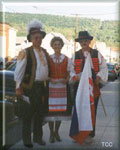
In today's society, many churches are closing their doors or the membership is merging with other churches. Because of dwindling membership or the lack of interest among church goers, many churches are becoming an empty shell. Some are left to deteriorate or in some cases, just torn down. In Lansford, there is St. Johns Slovak Lutheran Evangelical Church, whose membership just celebrated their 100th anniversary of its founding. In the early days, some of the Slovak membership worshiped at Trinity Lutheran Church in Lansford. In celebrating the 100th anniversary they have once again turned to Trinity Lutheran Church for the use of their pastor.
The Slovak Lutheran immigrants who came to the Panther Valley in the late 1800's to work in the coal mines found that they had to utilize other churches for a place of worship. On February 22, 1899 they met with the Rev. Ludvi Kavel, pastor of the Mt. Carmel congregation, who became the first administrator of St. Johns, to form their own church. The sad part is that there is no written records of that very first meeting. But through some of the Church Founder’s recollections, it was known that the first meeting was held in the so-called Neumuller's Hall, located on the corner of Ridge and Center St. in Lansford. There were 36 members present on that day. Just like anything else in life, deciding on a meeting place among its members caused the first rift, splitting it into two groups. One group wanted to worship in the Trinity Lutheran Church and the other in Nemuller's Hall and then later in the English Congregational Church, all in Lansford.
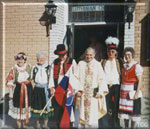 What happened is the members paid rental fees to both organizations. They paid the Trinity Lutheran Church, $60 a year rental and the other group paid $25.00 a year for Nemuller’s Hall. To the early immigrants this was a lot of money. We have to remember that the mine labors at that time got about eight cents an hour. Because of this they started making plans to build a church of their own. Every working member offered to give a day's wages, once a month, for a year to the building fund. Four members loaned money, interest free and because of this the building started. I'm proud to say that my Grandfather, George Zlock, was one of the four members to loan money to the church. My other grandfather, Frank Bayer, was one of the "Founding Fathers." In the fall of 1903, the church was well on its way to being built and on November 15, 1903, there was the first dedication of the corner stone. Being unable to afford a Slovak pastor that day, The Rev. Charles J. Gable of Trinity Lutheran Church was invited to take charge of the dedication. The singing of hymns were all in Slovak. We must remember that many of these immigrants could only speak Slovak and some didn't understand English. Rev. Gable didn't understand or speak Slovak. But through the grace of God, the dedication went forth. St. Johns was completed on May 30, 1904, a tremendous triumph for the new congregation! The dedication was performed in a manner befitting the occasion with three Slovak pastors present, all from neighboring churches of Mt. Carmel., Mahanoy City and Nanticoke. Still unable to afford their own pastor, Rev. Charles J. Gable again agreed to do the dedication. What happened is the members paid rental fees to both organizations. They paid the Trinity Lutheran Church, $60 a year rental and the other group paid $25.00 a year for Nemuller’s Hall. To the early immigrants this was a lot of money. We have to remember that the mine labors at that time got about eight cents an hour. Because of this they started making plans to build a church of their own. Every working member offered to give a day's wages, once a month, for a year to the building fund. Four members loaned money, interest free and because of this the building started. I'm proud to say that my Grandfather, George Zlock, was one of the four members to loan money to the church. My other grandfather, Frank Bayer, was one of the "Founding Fathers." In the fall of 1903, the church was well on its way to being built and on November 15, 1903, there was the first dedication of the corner stone. Being unable to afford a Slovak pastor that day, The Rev. Charles J. Gable of Trinity Lutheran Church was invited to take charge of the dedication. The singing of hymns were all in Slovak. We must remember that many of these immigrants could only speak Slovak and some didn't understand English. Rev. Gable didn't understand or speak Slovak. But through the grace of God, the dedication went forth. St. Johns was completed on May 30, 1904, a tremendous triumph for the new congregation! The dedication was performed in a manner befitting the occasion with three Slovak pastors present, all from neighboring churches of Mt. Carmel., Mahanoy City and Nanticoke. Still unable to afford their own pastor, Rev. Charles J. Gable again agreed to do the dedication.
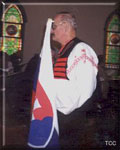 Festivities began with a procession through the streets of Lansford. In the lead were three church officers on horseback, followed by two horse-drawn carriages with the visiting clergy, a band, local and neighboring units of Catholic fraternal organizations with banners, and then friends and members of the congregation. The procession ended at the outside of the church, around the corner-stone, singing two verses of a hymn from their European Spevnik, the Kyrie and then the response. Then they began entering the sanctuary for the service singing the last two verses of the hymn. Now on to the present: St. Johns Slovak Lutheran Evangelical Church thought it befitting to recreate the dedication of the church. This time Rev. John Keiter, Pastor of the Trinity Lutheran Church, officiated. Although the re-enactment was done in English, Rev. Keiter gave the Kyrie in Slovak. I'm almost certain that if the founding fathers were looking down on this festive occasion, they were well pleased with Rev. Kieter’s attempt at the Slovak language. This time, at the end of the service, a small group marched up Abbott St. to the Trinity Lutheran Church. No horses, bands or horse-drawn carriages. Instead of the band it was led by a trumpeter and parish son, Edward Kalny, now of New York. Several of the marchers wore folk clothing that represented parts of their ancestral homelands of Slovakia. This folk clothing or "Kroj," as they are called, depict our heritage and are the way our founding fathers and parents dressed for special occasions, before coming to America. Yours truly, dressed in a Slovak Folk outfit also carried the Slovak flag in commemoration of my ancestor's homeland When arriving at the Trinity Lutheran church, Pastor Keiter, led us into the church and then down into the meeting room where Ann Trauger, President of St. Johns Church Council, gave a small speech, thanking the people of the Trinity Lutheran Church for the help in those early years when the church was first founded. Festivities began with a procession through the streets of Lansford. In the lead were three church officers on horseback, followed by two horse-drawn carriages with the visiting clergy, a band, local and neighboring units of Catholic fraternal organizations with banners, and then friends and members of the congregation. The procession ended at the outside of the church, around the corner-stone, singing two verses of a hymn from their European Spevnik, the Kyrie and then the response. Then they began entering the sanctuary for the service singing the last two verses of the hymn. Now on to the present: St. Johns Slovak Lutheran Evangelical Church thought it befitting to recreate the dedication of the church. This time Rev. John Keiter, Pastor of the Trinity Lutheran Church, officiated. Although the re-enactment was done in English, Rev. Keiter gave the Kyrie in Slovak. I'm almost certain that if the founding fathers were looking down on this festive occasion, they were well pleased with Rev. Kieter’s attempt at the Slovak language. This time, at the end of the service, a small group marched up Abbott St. to the Trinity Lutheran Church. No horses, bands or horse-drawn carriages. Instead of the band it was led by a trumpeter and parish son, Edward Kalny, now of New York. Several of the marchers wore folk clothing that represented parts of their ancestral homelands of Slovakia. This folk clothing or "Kroj," as they are called, depict our heritage and are the way our founding fathers and parents dressed for special occasions, before coming to America. Yours truly, dressed in a Slovak Folk outfit also carried the Slovak flag in commemoration of my ancestor's homeland When arriving at the Trinity Lutheran church, Pastor Keiter, led us into the church and then down into the meeting room where Ann Trauger, President of St. Johns Church Council, gave a small speech, thanking the people of the Trinity Lutheran Church for the help in those early years when the church was first founded.
Trauger finished off her presentation with the following: Today, a hundred years later, history has strangely repeated itself. As we were in May of 1904 without a pastor, here we are again, without a pastor of our own, and back to the Trinity Lutheran Church for a pastor, were we first started. We have come full circle, and the thread in the tapestry of life binds us together once more. She thanked the Trinity Lutheran members for allowing them to share this special day with them. I myself was honored to be invited, to partake of the re-enactment of the dedication and founding of the church where I was baptized. It's good to see churches celebrate anniversaries instead of church closures.
Lansford, Pennsylvania
Over a Century of Faith & Slovak Heritage
"Viera a Dedicstvo"
The Carpathian Connection would like to offer our deepest appreciation to Rev. Thomas A. Derzack, Mr. Paul J. Hackash and Mr. John C. Orsulak who have provided us with this history. We'd also like to thank Doctor Bob Valent for providing us with a photo of St. Michael's.
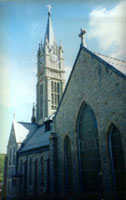 A Review of St. Michael's First 100 Years: A Review of St. Michael's First 100 Years:
In 1881, six men accepted the invitation of Mr. Eckley B. Coxe, a coal operator, to come to Pennsylvania to work in the anthracite "hard coal" mines. These men were Slovaks-the first Slovak Catholics of Lansford. On September 21, 1890, a fraternal society for Slovaks of this vicinity was organized at the Lansford Opera House. This benevolent organization of St. Michael placed itself under the protection of the Sacred Heart. The occasion marked the emergence of Slovaks from the shadows to which they were driven by their suspicious neighbors because they spoke a strange language and practiced unfamiliar customs.
In May, 1891, the Rev. William Heinen, Pastor of St. Joseph Parish in East Mauch Chunk, was passing the home of W.Z. Zehner, superintendent of mines, when the gardener addressed him. We recognize this caretaker as Mr. Michael Provaznik, who played a pivotal role in the affairs of the incipient parish. During their conversation, the talk turned to the erection of a church for the exclusive use of Slovak immigrants who settled in the Panther Valley area.
It was late June of that year when Fr. Heinen called a meeting of the Slovaks, again in the Opera House. Prior to the meeting, he canvassed the whole vicinity, personally inviting the people to the scheduled conference. All went well regarding the formation of the Slovak parish until Fr. Heinen informed the gathering that a plot of ground for the proposed church would cost about $300, with a further expenditure of $3,000 for an unfurnished church. The people were more than a little hesitant, for those were the days when a miner received 90 cents for nine hours of back-breaking labor. This drawback and other difficulties vanished before the intense desire to have a Slovak Catholic Church wherein they would once again hear the word of God in their beloved mother tongue. The members of the newly-formed parish decided to place their trust in the patronage of Saint Michael the Archangel.
Construction of Original Church Begins:
A wooded section on the southern edge of town was purchased by Fr. Heinen from the Lehigh Coal and Navigation (L.C. & N.) Company, a plot of ground 150 by 50 feet for $150. On July 18, after the men of the new parish cleared the land, the congregation began soliciting bids for the erection of a frame church structure 35 by 65 feet. Two weeks later, the contract was awarded at a cost of $2,450.
While the first church of St. Michael the Archangel was being constructed, the parishioners of the fledgling parish attended St. Joseph Church in nearby Summit Hill. Fr. Heinen had obtained permission to celebrate Mass in the Slovak language at 6:45 AM or at 12:45 PM on alternate Sundays.
Working at a feverish pitch, within a month it was possible to lay the cornerstone on Sunday, August 30, 1891. Building operations progressed so rapidly that on Sunday, December 20, 1891, the Slovak people of the Lansford and the surrounding Panther Valley area saw the realization of their dreams and the fulfillment of their hopes. The air was crisp and the sun smiled as the Slovak Roman Catholic Church of St. Michael the Archangel was dedicated by the Rt. Rev. Msgr. James Garvey, Rector of St. James Church in Philadelphia, acting as the Delegate of Archbishop Patrick Ryan.
The little church could accommodate 260 people independent of the choir's seating capacity. During the day, ten beautiful stained-glass windows bathed the interior in natural illumination. A marbleized altar filled the sanctuary. Life-sized statues of the Blessed Virgin and St. Joseph adorned the two side altars. The interior walls were neatly frescoed, and the altar railing was of yellow pine with walnut trimmings. This church, completely furnished, cost $5,200 and was an ornament to the neighborhood and a testimonial to Fr. Heinen and his parishioners.
Until they settled in Lansford in sufficient numbers and constructed their own church structures, Greek Catholic (Byzantine) and Polish immigrants either attended the Slovak devotions or celebrated their own liturgy in the Church of St. Michael. The steady influx of Slovaks to the community necessitated the addition of two side chapels in 1893. At the same time, a steeple was erected and three bells were purchased and installed in the belfry.
On Thursday, February 21, 1907, the frame church, the fruit of hard labor and many sacrifices, was destroyed by fire. Within an hour, the small church was a mass of charred ruins. From that sorrowful day, the parish had to utilize the parochial school building, dating from just the previous year, for their services of divine worship. St. John the Baptist Byzantine Catholic Church, located just across the street, offered the use of their church to celebrate the Holy Liturgy, which was gratefully accepted. Years later, when the Byzantine Church suffered the same fate, St. Michael's Parish reciprocated.
Present "Cathedral - Style" Church of Granite Built:
Wasting no time, on February 24, 1907, after Sunday Liturgy, the then-Pastor Fr. Joseph Kasparek called a meeting of the congregation to discuss the question of building a new church. It was decided to erect a church of stone. With funds seeded by insurance from the former church, on February 27 the parish purchased property from James McMichael which measured 60 by 150 feet. It was situated immediately north of the first site. On Memorial Day, 1908, the cornerstone, inscribed "Rim. Kat. Slovensky Kostol, Sv. Michala 1908-Roman Catholic Slovak Church, St. Michael 1908" was laid by the Most Rev. Edmond Prendergast, Bishop of Philadelphia. The officiating prelate was escorted from the Lansford train station by a mile-long procession formed by the parishioners and Slovak Catholics from throughout the region. At the time, the construction had progressed to the completion of the basement, where the Mass was celebrated while the remainder of the church was being built.
The construction of the church, which began in 1907, was completed by Thanksgiving Day, November 30, 1911. On that day, the new edifice, truly one of the most beautiful in the Archdiocese of Philadelphia, was dedicated by the late Archbishop Edmond Prendergast. The church, Gothic in design, is built of Gouverner, New York State gray dolomite marble in broken range.
Stretching from Abbott to Water Street, St. Michael Church is 150 feet deep and 60 feet wide: the transept measures 84 feet across. Original seating capacity was 1,100 worshipers. The lofty steeple is 169 feet tall with an attractive electrified timepiece set by the E. Howard Clock Co. Within the belfry are three bells, christened St. Michael (weight; 3,000 lbs), St. Stephen (1,500 lbs), and St. George (750 lbs). The mechanism was designed so that St. Michael strikes off the hours, St. George the quarter hours, and St. Stephen chimes the Angelus. To summon the faithful for Mass, all 3 bells were originally rung by hand ropes, but now are electrified.
For the next five decades during which St. Michael Church was in the Philadelphia Diocese, for obvious reasons it became known affectionately as the "Cathedral in the coal region." The parish was incorporated into the Diocese of Allentown when it was established by Pope John XXIII on January 28, 1961, from the Northern Philadelphia Archdiocesan counties of Berks, Carbon, Lehigh, Northampton and Schuylkill.
Priests, Religious and Pastors:
From 1891-1894 and 1895-1903, St. Michael was a mission-chapel attached to St. Joseph Church in nearby East Mauch Chunk, where Fr. Heinen was the pastor. Pastors who served St. Michael Church since its founding:
Rev. Joseph Kasparek (1894-1895, 1905-1912)Rev. Peter Schaaf (1903-1905)Rev. Paul J. Lisicky (1912-1955)Msgr. Joseph A. Baran (1955-1978)Rev. Joseph D. Hulko (1978-1982)Rev. Thomas A. Derzack (1982-present)
St. Michael Parish boasts a total of 33 ordinations to the priesthood and 59 women who have entered the religious life.
 The Carpathian Connection would like to thank Mr. David Kuchta for his continued support of TCC. Mr. Kuchta has spent years not only researching mines in the state of Pennsylvania but also working in them. Mr. Kuchta’s vast knowledge in this field has made him a celebrated author of numerous essays and works. Thanks Dave! The Carpathian Connection would like to thank Mr. David Kuchta for his continued support of TCC. Mr. Kuchta has spent years not only researching mines in the state of Pennsylvania but also working in them. Mr. Kuchta’s vast knowledge in this field has made him a celebrated author of numerous essays and works. Thanks Dave!
Courtesy of Stephen Miller
Courtesy of David Kuchta
by, David Kuchta
During the early years here in the Panther Valley there were two words that originally brought fear into the hearts of miner's wives: Black Maria! Around the coal collieries during and after the turn of the century there was a black covered wagon that was pulled by a team of horses. In later years this was a motorized vehicle that was later known as an ambulance.
During the mid to late 1800s, when people would see this "Black Maria," coming up the street, it brought shudders to those wives of miners who knew that just maybe, they were bringing home their husband or son. In those days, they used the "Black Maria," both as an ambulance as well as a hearse. If there was a bad accident at the colliery, a loud whistle would sound the alarm. But, if it was just what would be considered an average mining accident the whistle wouldn't be sounded. Just as in modern times, the word would get out that someone was killed and everyone thought the worst. Many of the local kids would see the "Black Maria," coming up the street and would be running along side or behind it like a procession. By this time the wives of the miners would be waiting or watching on the front porches or stoops hoping that the "Black Maria," would pass on by. Many of the wives would be praying the Rosary or silently wording desperate suplications to heaven.
During these early years, miners that were seriously hurt were taken by horse and carriage up to Ashland Pa. This was over very rough roads and was a long trip. Many a miner probably died from the rough ride or because of the length of time it took to get to Ashland Hospital. In time, trolley lines were in place from Mauch Chunk to Pottsville, Pa. This did help considerably. Then around 1910, the Coaldale Hospital was built and this was a real blessing for the local coal miners.
But before these trolley lines or Coaldale Hospital was built, everyone had to depend on the "Black Maria" to bring home their loved ones. Probably, the exasperating part was that the miner could be still alive but critically hurt. If the mine officials thought that he couldn't make the trip up to Ashland, he would be taken to his home for his wife to make him as comfortable as she possibly could for the short remainder of his life. If the miner was dead, they would place him on the front porch of his home. At this time, friends or neighbors would come over and take the body into the house, clean, dress him in his finest suit and prepare the deceased for his wake.
Just a few years ago, I always thought that the "Black Maria" was a local expression that was only used in the Panther Valley area. Then I started reading other books on coal mining throughout the entire hard coal regions, and saw this same words used for their ambulance or hearse throughout the entire coalfield regions. This term, "Black Maria," got me thinking about where these words originated. I thought that being the early years of mining here in Pennsylvania were done by Welsh miners that perhaps the word originated in Wales. How wrong I was! When I did research into this question about the use of a horse and carriage or vehicles called a "Black Maria," to haul the critically hurt or dead miners, I found that they used it during the Great Depression in the communities located in the western prairies. I found that it was something like an adaptation of the Model T Ford, and was used for transporting the deceased. Then, a good friend of mine came to the rescue and solved the problem of where the words, "Black Maria," originated. The "Black Maria," was the black van, which conveys prisoners from the police courts to jail. The French called it a mud-barge or a "Marie-salope." The tradition is that the van referred to was so called from Maria Lee, an African-American woman, who kept a sailors' boarding house in Boston. She was a women of such great size and strength that the unruly sailors stood in fear of her, and when constables required help, it was a common thing to send for Maria, who soon collared the refractory (person resisting control or authority) and led them to the lock-up. So because of this, a prison-van was called a "Black Maria." In time it was also used to describe an ambulance and a hearse.
by, David Kuchta
When I was a pre-teen, I used to go for haircuts with my father to George Swider's barbershop in Lansford, PA. The barbershop was first located at Patterson and Sharpe and then at his residence on East Bertsch Street. Since Swider was a fire boss at one of the Lansford Coal mines, a lot of mining went on while waiting for our haircuts. Sooner or later the subject of "boot-leg," mining became the topic. To those who don't quite understand the phrase bootleg mining¼it was usually a small mine operated by two to five workers. These were non-union and were built on property that didn't belong to the miners. In plain English; it was an illegal mining operation.
During the late 20s and early 30s during the "Great Depression," many miners were out of work and started their own bootleg hole. Many a family was raised on the money earned at these enterprises. Also, if it was not for the bootleg mine holes many homes would have been without heat during the winter season. Union miners had a love/hate relationship with "Bootleggers." If the miners worked, they couldn't care less, but if the legal mines were shut down or on strike the "Bootleggers" sold the coal cheaper and ran their operations on a shoestring. Most wouldn't pass a State Mine Inspectors rigorous inspection. They also didn't pay into the "Health and Welfare Fund." The locations of these illegal mine operations were kept secret. Any roads to the operations were kept camouflaged with branches, etc. Most of these mines were slopes driven on a steep pitch. The hoist motors would be the back axles of old cars or trucks hooked up to rigging that hoisted a small bucket or barrel, up and down the slope. Most of these buckets or barrels were pulled up on wood skids. Not too many used rails and small railroad wheels in their project. In the bigger mining ventures the car or apparatus to pull up the coal to the top of the tipple was a "gunboat." Most of these operations were in Schuylkill County on Reading Anthracite Coal Property. The larger coal companies went after the bigger veins of coal and didn't bother with the five or six foot veins.
The Coal Companies knew the approximate location of all the coal veins way back in the 1800's. The state had entire coalfields all explored and mapped out. In the larger valleys with mountains on both sides of it, it is not uncommon to have up to eight larger veins of coal running in an east, west direction. These same veins are located on both sides of the valley. The veins go deep down, under the valley and then come up the other side. Like I had said, most large operations didn't go after the smaller veins until after the mines had closed down and "strip-mines," became more popular. Some of the larger veins were from eight to ninety-feet thick with some forming a roll action and being over 150 foot in width. These were the Mammoth Veins and were the most popular veins to be mined. During the hay-day of mining, the larger mine corporations could have up to eight levels of mine operations below the bottom of the valley. When these mines were in operation, large pumps were used 24 hours a day to keep the water out of the working areas. It is a fact that about 20 tons of water had to be pumped from the mines for every ton of coal. So you can see that the expense is quite high in deep coal mining. Plus, all the mine water that is pumped out of the mines must be treated. The environmental expense is staggering.
The boot leg mines or smaller independent mines can't afford large pumping expenses. In this day and age there are only a few bootleg operations existing. There are many independent mines that sign leases with the landowner to mine coal. They either pay royalties on a ton of coal or sell all the coal that is mined to the owner for a predetermined price. These independent mines fall under the regulations of the State and Federal Government and are inspected by State Mine Inspectors. The smaller bootleg operators try to drive a slope in the vicinity of old workings. This way they drain all the water into the old mines. Of course there is always danger from the old workings because of cave-ins or even water accumulating in old gangways and breaking into new mines. Down through the years, many a bootleg miner lost his life in these illegal operations. All mines are charted and the state knows where old workings are located and were the pillars were robbed. Well usually! I have a friend who had one of these bootleg mines. It was in a part of the mountain that hid the operation from the landowners but some local bikers found the mine and supposedly reported it to the authorities.
The State Mine Inspector that checked out this mine was impressed with the way it was driven but when he received a complaint about them he had to shut it down. If my mind remembers, he blew it shut with dynamite and then had the local contractor come up with one of his bulldozers and doze it shut. In this case, the mine was a safe operation but was illegal as far as the landowners were concerned. Today, some of the smaller veins are mined with small buckets on a drag line shovel. I also would imagine that with today's helicopters and snoop planes, the illegal bootleg mine operators will be a thing of the past. If there are any of these illegal mines in operation in this day and age¼they are kept a secret!
by, David Kuchta
When mining started in the Panther Valley, injured miners were taken to local doctor's office. If he was hurt extremely bad, the injured was hauled to the miners home, deposited there and left to the miners wife to make him as comfortable as possible during those last hours of his life. An interesting thing is that they used the "Black Maria," wagon to deliver both the injured as well as the dead miners to their homes. When people saw the "Black Maria," coming up their street, they thought the worst. During the later years of mining in the Panther Valley, badly injured miners where taken by horse and wagon all the way up to Ashland State Hospital. The roads were in terrible shape, and if the injured miner was hurt seriously, the ride there usually did him in.
During early 1900, streetcars were utilized to haul the injured to Ashland or Pottsville. The ride was much smoother but it still took too much time to reach their destination. Because of this distance from Ashland or Pottsville hospitals, the Coaldale Hospital came into being. In 1909, the miners of the valley volunteered a full days pay for the construction of a hospital while the Lehigh Navigation and Coal Company through the efforts of the Superintendent Ludlow, donated a site for the building. The Coal Company also told the miners that every dollar they donated; the company would also match that amount. The location of the hospital was east of the village of Seek. The hospital would overlook the valley and was built in a very pristine area. This area was where John Moser had built his first home, which was the very first home in the area, which became known as Coaldale. The building was completed on July 11, 1910. The contributions amounted to $50,000. The structure was a three-story brick building and was originally built to accommodate 30 patients. The hospital soon averaged 68 patients. The hospital was divided into three wards; two for men and one for women. Because of the congestion, every available room was utilized at all times. Later, they enclosed the two large porches on the south side which gave the hospital eight additional beds.
In 1911, the interior of the hospital was destroyed by fire. All patients were taken to nearby houses to be treated. Luckily, the homes were empty at the time. Throughout the years, the hospital has been in continuous operation. In 1934 the majority of the patients were miners of the valley, and that there were more surgical cases presented than medical cases. In the men's ward at one point of time, there were a large number of broken limbs, nine of which were suspended from slings, swung from overhead. There were also a large number of burned patients. One was a survivor of the Foster tunnel entombment. At the time he was in the hospital suffering from burns sustained in the mine explosion. The laundry, laboratory, and dispensary are located in the basement. The dispensary, which is quite small for the work being done, has about 80 patients per day. A modern X-ray machine, classed as one of the best for those early years, a modern kitchen with all the latest equipment and complete refrigerating plant were all added. The first nurses in the hospital were; Miss V. Kazakewica and Miss Nellie Close. The first patient admitted to the hospital was Stephen Snikschak from Lansford who was admitted on July 14, 1910. In time new wards were added for burn victims, women and children, including an isolation ward and corridors. Being that the original capacity of the hospital was 30 beds, there wasn't enough beds for new patients so 10 more beds and six cots were crowded in, allowing scarcely enough room between each bed for a nurse to attend the patients.
When possible the overflow was taken care of by placing two patients in one bed, and other are asked to sleep on the floor with blankets. To eliminate this problem, the Board of Trustees limited the class of patients admitted. Because of this some patients had to go 25 or more miles away to other hospitals. In time the board had to recall this order. Dates of new buildings are the following; the original building was built in 1909, the new annex, in Sept. 1927, and the nurses' home in 1933. The employees originally numbered 15 and in 1934 numbered 59. The bed capacity was originally 30, and in 1934 was 92. John Prostovich of Poland, was the first man to die in the hospital. The opening of the new maternity department was in January, 1932. The first child born there was Daniel Conahan of Seek, born on January 1, 1932. In 1927 ground was broken for the Nurses Home. For some reason work on the building ceased in 1929 when it was almost completed. Probably because of the Great Depression, things like this were curtailed. This building stood vacant until 1933, when the Board of Directors managed to cut all the necessary red tape with the State Department, and then preparations were made for its occupancy. I hope you have enjoyed the trip back into time.
by, David Kuchta
Just what do we know about the history of coal mining. When did it start? Where and how did it evolve down through the years? Frankly, I don't think too many of us have the faintest inclination about the history of coal and coal mining. I also don't think that anyone under the age of 40 remembers seeing our coal breakers or even hearing the high shrill whistle of the small coal mine "Lokies" going through the valley. These are sights and sounds that will never be seen or heard again. The younger generation and baby boomers probably never saw a coal miner walking to the lamp shanty in gum boots, face and clothes all blackened by coal dust! This is all part of our mine heritage, but only a small bit, because there is so much more to know. Before I got involved with the No. 9 Mine and Museum, I was just like everyone else. I read and heard how mines were damp, dark, deep, dusty and at times dangerous. It was also drummed into me by my father, that I wasn't going to end up working in a mine like him or my grandfathers. With five years of doing research and also working every weekend in the No. 9 Mine, I have learned a lot about the history of mining. When the old timers spoke, I listen! When I wrote my book, "Once A Man, Twice A Boy," I interviewed quite a few old time miners. But instead of researching the run of the mill information I researched out other information about horseplay, pranks, cheating by the company and the miners and also about kickbacks to the fire bosses. This kind of stuff wasn't discussed no less read about. I'm continually learning a lot about our coal mining past. I also enjoy writing about it and preserving this heritage for future generations.
When I went to school, many moons ago, the teachers drummed into us kids that Philip Ginter discovered Anthracite coal in Summit Hill in 1792. They made it sound like this was the first coal every found in the State of Pennsylvania, or as far as I was concerned the world! I soon found out that this discovery was strictly only for Carbon County, which doesn't take in too much area as far as coal mining is concerned. Anthracite Coal was already discovered in parts of Wyoming County (which at that time was a part of the large Northampton County.) To get a better idea of when and where the first coal mines were, I will try to give a break down through the years about the finding and use of coal. The very first coal mined that is recorded was coal that was mined during the Roman Occupation of Britain in 55 BC to 436 AD) along the banks of the rivers Clyde and Forth. Later in Britain coal was mined by the monks of Holyrood and Newbattle Abbeys in Scotland and also by the monks of Northumberland. In 1215 coal was mentioned in the Great Charter of King John Here is an interesting tidbit about coal mining. During King Edward’s reign (1239-1307) he imposed the death penalty to anyone using coal because it was believed that it gave off, "poisonous odors." That bias against the use of coal lasted for about two centuries. Most of us "Coal Crackers" think that the first coal discovered in America was in West Virginia or Pennsylvania. Sorry, not so! The first coal discovered in America was in 1673 near present day Utica, Illinois. This is credited to Louis Joliet and Jacques Marquette. It was also Benjamin Franklin who converted a fireplace that he had invented in 1741 to burn coal and subsequently invented the coal stoves that burn both Anthracite as well as Bituminous Coal. Although most of us senior citizens know what went on above the ground, so little is known what went on underground. We know so little about the profession of "coal mining." Coal mining wasn't just a hit and miss type of venture. Most mines were well planned and engineered. The coal companies knew were the veins of coal were located but when it came to inclines, rolls or pitches this was something that was found out when the tunnels and chutes were driven.
The surprising part of our coal heritage is that there is literally millions upon millions of tons of coal (some recoverable, some not) still in the ground after all these years of mining. Most of the easy (getting) coal is already mined. What is left are huge deposits of coal deep in the ground. Under Pottsville is the huge mammoth vein, which is from 100 to 200 feet wide. But with present day technology it is impossible to mine. The vein is 2,000 feet down. The biggest problem would be the expense of mining it along with removing all the water. Years ago they had to pump 20 tons of water for every ton of coal removed. With no concerns on river pollution this wasn't a problem but now with strict environmental laws this water would have to be treated and cleaned before being pumped back into our streams. The Mammoth Vein of coal is also under the Panther Valley, along with the other various veins of coal. In the future with more modern technology and better systems of mining, this coal may be mined. Of course, if a better way of mining and more economical and more environmental friendly fuel is discovered (such as Hydrogen) then the coal will stay where it is forever. Just knowing that the coal reserves are still there in the ground does put us in a more advantageous position over other countries around the world where there coal reserves are gone or where oil reserves are slowly getting depleted.
by, David Kuchta
On September 27, 1915, eleven men were entombed in the East Mammoth Vein of the Foster Tunnel. It was a water level opening of the Lehigh Coal and Navigation Company, situated on the Southwest boundary line of the town of Coaldale, Pennsylvania. A sudden rush of water from the East Mammoth top split gangway, an abandoned working area, entombed the 11 men for six full days. According to LC&N records, the 11 men were: four contract miners, two laborers, a battery starter, a loader, two mule drivers and a door tender who were involved in driving the chute that eventually flooded. It might be well to note that the East Mammoth top split gangway of Fosters tunnel had been worked and the breasts broke through into the East Mammoth top split gangway. The water, which closed the bottom split gangway, came from these breasts. No trouble was ever experienced with water problems in any of these breasts. In Chute No. 24, the water broke through at eleven o'clock on the morning of September 27 after a shot had been fired by William Watkins and Gint Hollywood, two competent miners, who were engaged in driving, the slant chute.
Both men managed to work their way amid the water and debris down the chute to a crosscut into and up No. 23 chute where they were entombed for 22 hours. The volume of water that broke through made its course from the old gangway, down No. 24 chute gutting it out as the water went along. The water broke down the pillars of coal between chutes Nos. 24 and 20. It violently eroded the No. 20 breast, which was enlarged three times its normal size. From there, the water and debris went down No. 20 chute into the gangway and then proceeded toward the mouth of the tunnel. In its course the water picked up timbers, rocks, coal and fine material, to close and compact the gangway from No. 19 chute to No. 25 chute. This distance is approximately 300 feet long. Upon being notified of the accident, General Inside Superintendent W. G Whildin and Mine Inspector I.M. Davies immediately went into consultation and under their supervision, rescue parties and plans for re-opening the gangway were promptly formed and put into immediate operation. Three rescue parties were formed and definite work assigned to each. One party was to make a narrow opening on the top of the gangway, and another party was to open the airway or monkey gangway and the third party was to follow the first party into the mine for re-opening the gangway to its full width.
It is reported that 150 workers took part in the rescue efforts. The party, which was opening the gangway to its full width, started at the No. 3 chute and cleaned up such materials that were carried by the water in its course toward the tunnel mouth. The rescue party, which worked the upper lift of the gangway, started at chute No. 19 and opened a hole 3 by 4 feet along the south rib (Wall of the tunnel.) This work was tedious and slow due to the extreme difficulties which were encountered along the gangway. Between chutes No. 20 and 21 the progress was impeded by striking a steel mine car and truck that was caught in the flood-waters. By means of an acetylene torch, enough of the mine car was cut away to permit the men to follow the north rib and proceed with the rescue work. At the time that the men were rescued, this rescue party had advanced very close to chute No. 25 where the mules were found amid the old timbers, rock, coal and other debris. The rescue party which advanced along the airway started at chute No. 19 and proceeded on to No. 20 where it was found that the pillars of coal had been washed away leaving No. 20 breast almost three times its normal size.
Three sets of timber, well planked, were used in crossing this breast and the rescue party advanced along this airway. The coal pillars between chutes Nos. 23 and 24 were badly damaged and extra precaution was used in opening this area. When reaching chute No. 26, black damp, CO2 was encountered and it became necessary to use a supply of compressed air to drive it out in order that the work might continue. Chute No. 26 was the first chute found opened and after driving the black damp gas out, the men explored the chute to its mouth and found the gangway filled with water. Two electric pumps were used in lowering this water and when sufficiently lowered, a raft was built and further explorations in the gangway began. On Oct. 3rd, John Humphries, the foreman at Foster's tunnel while on the raft, shouting as he went further into the mine, made contact with Elmer Herring. Elmer Herring who was the strongest of those imprisoned, came down the chute where the men had taken refuge. Herring yelled, "My God man, turn your light the other way, it is blinding me." Humphries asked Herring how were the other men? "All alive!" was Herrring's response. Subsequently, Herring led Humphries to the rest of the men huddled in Chute No. 27. At chute No. 27, the men were found all alive and in good physical condition. A temporary platform was built along the legs of the gangway timbers and each entombed man, after being trapped behind a wall of water, timber and loose coal for six days and five hours, was slid along this platform to chute No. 26. They went up the chute and along the course which was opened by the rescuers to chute No. 20 ½. Then, they were taken down the cute to the gangway where the company physician gave them hot coffee, and when necessary, a hypodermic injection to stimulate their weakened hearts.
The rescue was done in a very thorough manner. Each man was carried on a stretcher from No. 20 ½ chute to the ambulance at the tunnel's mouth. A slip of paper showing what treatment had been given each worker was given to the captain of the stretcher squad. This was delivered it to the physician of the Panther Valley Hospital, (Coaldale) where the men were taken to recuperate. After the rescue, all the debris that had fallen into the tunnel was hauled away, having filled 588 coal cars and 86 trucks. With the probability of more cave-ins, dangerous conditions from old timbers laying about in the mud and debris, black damp gas, and just the mere fact of further flooding, this rescue has to be considered as miraculous. Much credit was due to Mine Inspector David J. Roderick of Hazleton, who responded promptly when asked to assist with the rescue work and also to all the employees of the coal company without whose noble efforts nothing could have been accomplished.
by, David Kuchta
Most miners carried a lunch can to work with a lid that held water. The miner would take the container of water, take off the cap and hold the can upside down to drain out the water, right on the floor of the Wash Shanty. Then he would holler, "Domu," which in the Slovak or Polish language means home. At that point everyone was ready to head on home or to the nearest gin mill. At times this did get out of hand. On one occasion one of the miners came into work with a terrific hangover from a long night of celebrating. Not wanting to work, he just emptied his water can, hollered "Domu," and everyone went on home.
There were periods of time, that there were short walkouts or strikes each and every month. Some of these got to be known as the "Strike of the Month." Some were for a just cause, some were over nonsense. I would imagine that many of these disagreements could have been worked out with an amicable agreement. With working conditions as bad as they were, it didn't take much to set off the workers. Perhaps what was written in the Lansford, Valley Gazette in July, 1975, explains it all. A coal mine is six dimensional; Dusty, deep, dark, damp, dirty and dangerous. Any one of these "D" words could aggravate a miner on any given day. Living in the Southern Hard Coal fields all my life, hearing my father or his friends discussing all the various problems at home, in the local gin mills, or at the barbershop that he went to, I heard it all. There was a point in time, that they thought that a Labor Party (not communist) but a party of all the blue-collar workers in America would have been organized during his lifetime. This never materialized and now it is too late. Just maybe the fact that the communists or socialist party used the words Labor Party in their title, made workers back off. Most of the various unions that represent the blue-collar worker in the 1990's have lost their clout. Now that I have aged and matured, I understand what all the complaints were all about.
May to October, 1902 Strike:
When Photographer, George Harvan gave me the book regarding the 1902 strike to research about some of the local riots, assaults, and other covert acts on the part of the strikers in the Lehigh Coal and Navigation Company area, I figured that I would just do a little synopsis of all the details. After reading through four pages of these incidents, I thought it necessary to show the reading public all the hostilities that happened during that strike. It is extensive, but accurate. It comes from the book, Report of the Anthracite Coal Strike Commission.
Writers comments:
When you read through this report, you will see the word Hungarians used to designate certain factions of workers. It is my opinion, that most of these so-called Hungarians were mixtures of the Slavic people. In those days, Czechoslovakia was Austria/Hungry. Although the people in what is now called Slovakia, were Slovaks for centuries before. People who came from Eastern Slovakia listed their country as Hungry.
The English-speaking and American born people called them Slavs and some did use the word; "Hunky." These people were from the plains and mountains across Eastern Europe and the Balkans. They were Poles, Rusyns, Ukrainians, Czechs Slovaks, Serbians, Croatians, Russians and others. Included in this is also the eastern part of Austria that later became Slovakia. On my grandfathers mining certificate, the birthplace is listed as Austria, although he was born and raised in what is now called Slovakia.
These poor souls were threatened by the company that they would be evicted from their company homes if they didn't report to work, and when work would start again, they were threatened that they wouldn't have any jobs to return to. Having no savings to carry them through the strike, many had to make the decision to either honor the strikers and stay home, or go to work. Those going to work were intimidated and even beaten. Some of those who honored the strike had their belongings thrown out on the sidewalk, by the Coal Company, and evicted from the company homes they lived in. Many of these people had to move in with relations or friendly neighbors. Many just packed up their belongings and moved away from the coal regions. Some immigrants became so disillusioned with what was happening that they went back home to the countries of their origin. These had to be the worst of times.
by, David Kuchta
May 16th. A large body of strikers surrounded the men loading stock coal at Hauto and threatened that if they did not cease work they would be stoned to death. Since then, these men have been fed and lodged by the company, all the while working and living under a strong guard day and night. June 2nd. The engineers and firemen were called out on strike. Many others did not immediately dessert, but through intimidation and fear of assault they were afraid to continue at work. In the course of a week few remained at their posts. June 4th. At Nesquehoning, houses of engineers remaining at work were stoned. Briggs, the engineer at No. 6, at night, in the presence of his wife, was threatened with bodily harm if he did not cease working. His wife was thrown into hysterics. June 8th. A large meeting of strikers was held in Lansford Opera House, at which Union President Johnny Mitchell was expected to speak. As a result of the meeting, the next morning June 9th, large gangs of strikers congregated on the street corners as early as 3 o'clock and by threats and intimidation turned back many of the men on their way to work.
June 11th. The Sheriffs of Schuylkill and Carbon counties were asked to restore peace. A young man, named Ackerman, in going to work at the Lansford shops, was surrounded by a large mob, and hit with a terrific blow in the face by a big Hungarian. Mobs made midnight calls at the houses of men who were away at work to frighten their wives with threats of blowing up their homes with dynamite if they did not persuade their husband from going to work. The following day, merchants, butchers, milkmen and bakers were warned by committees of strikers not to furnish the necessaries of life to the families of men at work or suffer the penalty of a boycott. A Hungarian working at No. 10, was captured in Tamaqua by Coaldale strikers, and marched him to McAdoo. To make the journey as painful as possible, they placed pebbles in his shoes.
June 16th. Mobs kept a number of stable bosses at home, thus preventing them from looking after the mules. June 28th. Strikers beat Martin Poinitski because he persisted in working. Both he and his wife were assaulted while on the way home from work. The following day, Hungarian workmen were kidnapped by strikers and forced to walk to McAdoo. June 30th. The clay gang was stopped from going to work; Policemen escorting men to work in the morning were attacked by mobs. Coal and iron Policeman Harris, in getting off a trolley car while on the way to his home, was surrounded by a mob and accompanied as far as the door of his home. Threatening to follow into the house, he drew his revolver and drove them away. Later on, he was arrested and put under bail for carrying a concealed deadly weapon. Four coal and iron policeman, in trying to make arrests at noon, were surrounded by a mob, pushed around, beaten and one badly wounded. A Hungarian was kidnapped and marched to Tamaqua by Coaldale strikers. The man was badly beaten. Thomas Barr and Henry Shaeffer, coal and iron policemen in protecting a Hungarian going to work, and attacked by a mob, were interfered with and beaten. The policemen swore out warrants against the leaders of the mob, who were released under light bail.
John Pashuta was forcibly taken off the pavement on Ridge Street, Lansford, and marched down the valley toward Tamaqua. He was beaten, kicked and dragged by his heels, and left for dead by the roadside. He was disabled through the severe treatment given him, and the doctors say his injuries are permanent. Chief of Police Chester and Assistant Superintendent Snyder, in endeavoring to rescue Pashuta were surrounded by the mob, thrown to the ground, jumped upon, and robbed of their revolvers. July 5th. At the Baseball Park in Lansford, stones were wedged in the guardrail of the trolley road. The same place was blocked a number of times afterwards. July 7th. William Black, a workman at Summit Hill while coming out of the hall of the P. O. S. of A. was surrounded by strikers and marched to Coaldale. There by the order of the secretary of the Coaldale local, he was taken to a clubroom where he was abused and obliged to swear that he would not go to work again. After he had taken the oath, the officers discovered that it would not be safe to let him get in the hands of the mob outside of the building, so he was finally taken out the back way by some of the prominent strikers and given his liberty.
The following day, Elmer McCready and Samuel Nevins, Jr., two young men working at Colliery No. 4, were assaulted and beaten by a body of strikers. Eight to ten of the strikers being known by the young men, were arrested but the justice, putting them under light bail released them.
July 9th. M.B. Weidleich, a coal and iron policeman, was surrounded by strikers on a street of Lansford, at dusk, and marched to Coaldale, beaten, shamefully abused and stripped of all his clothing, but his drawers. In this condition he walked to his home, a distance of several miles, which he reached in an exhausted condition. He was confined to bed for several weeks by his injuries. The following day, James Snyrle, a brakeman, living in Summit Hill, just as he was leaving his home in the morning, was captured by a mob of strikers and marched to Coaldale. He was badly beaten, and had his nose broken and was near stripped nude. He reached him home without shoes and little clothing. Smyrle was laid up for a week or more on account of his injures.
July 10th. The sheriff of Carbon County applied for troops, and to impress the governor with the great need of them sent a committee of Lansford citizens to Harrisburg. He made a personal appeal to the governor that he should send troops to the Panther Creek Valley to protect life and property, and which at that time the governor refused to does this.
July 13th. Samuel Meese, a stableman at Nesquehoning, was chased by an angry mob of strikers. To escape them he took refuge in the home of a friend. The following day, Harry Hornsberger, a coal and iron policeman stationed at Lansford shops, while going to work and still within 40 feet of his home, was assaulted by strikers and threatened with death if he did not desert his post. Hornsberger had one of the assailants; Daniel S. Lewis arrested and put under bail.
July 26th. John Heugle, a brakeman working for the company and living at Hauto, was captured by his neighbors, strikers, and marched toward Nesquehoning. Word being phoned to the Lansford office of the kidnapping of Heugle, a force of policemen boarded an engine, overtook the mob and rounded up forty-seven of them. All were brought to Lansford and put in the lockup. Later in the evening, when the door of the lockup was opened to take the prisoners to the squire for a hearing, with the aid of a lot of Lansford strikers the greater number escaped. However, all were finally put under bail to appear at court. July 26th. The wife of Heugle while trying to help her husband escape from the mob was knocked down and jumped upon by George Jyumber, a striker.
Jyumber was arrested and put under bail. In the evening, Arlington switch was half thrown open and blocked with stones and iron. This was discovered by a motorman just in time to prevent a serious accident. August 4th. During rioting at Summit Hill, a number of workmen were beaten and a trolley car was held up. August 11th. Thomas Reeves, a conductor, was pulled off his car at Summit Hill by a mob of strikers. August 18th. William Ronemus, whom he was assaulted, killed pay Sharpe at Nesquehoning. Troops were again asked for, and a battalion of the Twelfth Regiment arrived at Lansford the next morning. During the day, they located permanently at Manila Grove. August 23rd. Rails on the trolley road and the Coaldale grade were greased. A Hungarian was abused and assaulted by strikers on the pike leading to the Lansford office.
The following day, a guardrail on a curve at the Baseball Park was filled up with stones and blocked. August 25th. Peter King, a non-union man was robbed by strikers on Center Street, Lansford while on his way to work. To avoid being mobbed, he went to his home one day a week.
William Henry was not allowed to leave his house by a mob of strikers, and was kept in until August 27th. August 26th. Thomas Barr and Edwin Fritz coal and iron policeman was badly beaten by a mob of strikers in Coaldale; 17 strikers were arrested for this offense. Strikers abused Mrs. Samuel Pollock, a wife of a workman, and her clothes were torn off her while on the streets of Lansford. A Hungarian, named Shoemaker, was badly beaten by strikers in Lansford. August 27th. A bullet was fired by strikers into the home of W.C. Henry. The next day a detachment of soldiers was sent to guard the house of Henry. They remained on duty the entire night. Strikers started two cars of railroad sills down the Summit Hill grade. The cars derailed near the No. 4 breaker and were completely destroyed. The lock and chain on a switch was taken off and thrown away. August 29th. Strikers in early morning, at Lansford Opera House, jeered and hooted the soldiers. The soldiers making a charge on the strikers drove about forty of them into the Opera House. Many of the men in their haste, broke windows to get in.
John Kelly and Frank and John King, strikers, while insulting soldiers, were captured and put in the guardhouse. August 30th. W.C. Henry, being surrounded by a mob, drew his revolver to defend himself. September 4, the trolley track to the car barn was blocked once again with stones, sills and beer kegs, requiring ten minutes to clear away the obstructions. September 12th. A Hungarian, working at No. 4 was caught by strikers near Lansford shops and terribly beaten about the head. In a semiconscious state, he wandered to the camp at the Manila Grove, where the soldiers dressed his wounds Two other Hungarians were assaulted by strikers in Lansford and badly beaten. September 13th. Through the accidental discharge of a carbine, a Hungarian laborer was killed at No. 4 Colliery. September 16th. The behavior of the strikers, who interfered with the funeral of the Hungarian accidentally killed at Colliery No 4, which took place from his boarding house on West Bertsch Street, Lansford was most disgraceful.
The strikers held up the funeral for an hour and a quarter, insulting the preacher of the Lutheran Church to which the Hungarian belonged, while conducting the services, and threatening the pallbearers with severe punishment if they attempted to remove the corpse from the house. At the graveyard a mob of about 1,000 gathered to hoot and jeer, and when the grave was partly filled up, they desecrated it. September 17th. Thomas Richards, serving as a coal and iron policeman, in order to escape neighbors who were persecuting him and his family, moved to a quieter part of Lansford. His moving was greatly interfered with by the strikers. The following day, Charles Loftus, another coal and iron policeman, while moving to another part of town was interfered with by the strikers. His family was offered all sorts of insults, by hooting, jeering and dancing around the wagon and by prodding the team of mules, which caused a runaway, with the result that a piano on the wagon was dumped off onto the street and badly damaged. Not satisfied with this, the strikers further damaged the piano by throwing stones at it.
September 27th. Strikers surrounded the house of John Hunsicker, living in Summit Hill, and to keep him from going to work threw stones at the house, breaking in the windows. A detachment of soldiers was sent to protect him on his way to work. September 30th. Archie and James McMichael, while taking a boy to work at the Lansford shops, they were surrounded by a mob of strikers, who were throwing stones. Archie McMichael with his revolver dispersed the mob.
September 30th. W.C. Henry to have peace was obliged to move out of his own home into one he rented in the East Ward of Lansford. Crowds of strikers congregated a the corner of Bertsch and Center Streets and the corner of Ridge and Center Street in Lansford, waiting to interfere with workmen going home from work. Soldiers sent for that purpose dispersed these strikers. October 1st. A train of coal cars was derailed at No. 9 switch. The strikers learning of the derailment assembled in large numbers, and in various ways interfered with the railroad men in getting the cars back on the track. The mob became so violent that a detachment of soldiers was called for to disperse it. Mrs. Bristricke was cook in the No. 10 stockade during the strike. Before going to the stockade she lived with Mike Nickles, and left all her belongings in his house excepting what she needed at the Colliery. Nickles and his wife also took work at the colliery and while employed locked up their house.
Upon return from he Colliery, they found their home had been entered, and the contents destroyed. The legs of beds and tables were sawed off, trunks were broken beyond repair to get at the contents, and the bedding was ripped to pieces and the clothing belonging to Nickles and his family. The sleeves of coats and legs of trousers were cut off. Skirts torn apart, furs cut to pieces and certain portions were all burned up by building a fire in the middle of one of the rooms on the first floor, which burned a large hole in the floor. To protect property and workmen, to keep the pumps running, and to load and prepare coal, 323 men were kept in stockades and boarded and lodged. The greater number of these men didn't get away from the stockades for months.
In addition to the above, there were five cases of kidnapping, many riots, cases of assaults and battery, and any number of cases of intimidations.
Author’s thoughts:
What I am writing is something that no writer has ever written or dared to mention. I do wonder when the strike was over, if all the workers that were beaten, harassed and ridiculed by their neighbors or fellow workers, if they let bygones, be bygones. If they just shrugged off all the torment and humiliations that they went through, or did they even the score down the line. I wonder how many vendettas came out of this strike. Somehow, I think the score was evened out, one way or another. In Lansford, my own mother and father told stories of where certain buddies of some workers ended up getting killed by a so-called premature firing of a charge. The company thought of it as suspicious, but no one could prove otherwise.
Commission established, thus ending the strike:
To settle this strike a commission was established and after long hearings it came down to the final summations for both sides. Clarence Darrow, the famous "attorney for the damned," led the miners' team; former U.S. attorney general Wayne MacVeagh, the operators' group.
Darrow, with his dramatic flair and florid phrases sought to win his audience by reaching into their hearts. Gentlemen, addressing the opposition, "this was an industrial war, you on your side were fighting 147,000 men with their wives and children, and the weapons you used were hunger and want. You thought to bring them to terms by the most cruel and deadly weapon that any oppressor has ever used to bring men to his terms, hunger and want. Darrow spoke for a total of eight hours without using a single note. At the conclusion of Darrow's summation, the overflow crowd in the Philadelphia courtroom gave him a standing ovation that lasted for more than five minutes.
On March 22, 1903, the commission announced its findings and awarded the miners a 10 percent pay increase, a sliding wage scale and an eight-hour day for several types of work, and weighing men, to be paid by the miners. Also a board was set up to adjudicate all disputes arising between the miners and their employers. The commission also prohibited discrimination against union workers and criticized the employment of children. By this strike, all sides benefited. But in his final speech before the Anthracite Coal strike Commission, Attorney Darrow described better than anyone what the Anthracite Miners had really won in their Great Strike of 1902. In his mind it was a primarily a spiritual victory. The blunders are theirs, and the victories have been ours. The blunders are theirs because, in this old, old strife, they are fighting for slavery, while we are fighting for freedom. They are fighting for the rule of man over man, for despotism, for darkness, for the past. We are striving to build up man. We are working for democracy, for humanity, for the future, for the day that will come too late for us to see it or know it or receive its benefits, but which will come, and will remember our struggles, our triumphs, our defeats, and the words, which we spoke.
by, David Kuchta
Sept. 10, 1997, was the 100th year anniversary of the Lattimer Mine Massacre. The one-thing historians do agree on is that the Lattimer Massacre was the stimulus for miners and other workers to unionize. This intolerable act against the miners certainly worked against the large mine owners. Public sympathy fell upon the side of the miners and one thing is for certain, the Lattimer incident is one of the most important labor events in the history of the working men or women throughout our great nation¼especially here in the Anthracite Coal fields of Pennsylvania.
In the earlier years, the miners were mostly English, Welsh and German. Around 1846, the Irish started migrating to the coal fields of Pennsylvania. The Irish seemed to get all the work that the other ethnic groups didn't want to do. In the early 1880s, the Slavs started migrating to the coal fields. Most of the Slavs were of Polish decent and Hungarians, Slovaks and Rusyns from what was originally named Austria/Hungary, which later became Czechoslovakia and now the Slovak Republic. When the Irish started getting better paying jobs, the Slavs filled in on all the hard, dangerous and low paying jobs that the Irish once had. At this point of time the Slavs became the minority workers. In the early years, the Irish distanced themselves from the Slavs, being that the Slavs talked, dressed and acted differently than the Irish. In all reality, each group kept to themselves. I would think that the Massacre at Lattimer helped unite the Irish and the Slavic people into what became the largest most powerful labor organization, at that time.
The problems started near the end of the summer of 1897, when the large mine owners insisted the miners take a wage reduction and were also asked to take on added responsibilities. In those days, the miners would get together and march from mine to mine to ask the other miners to shut down the mining operations and join them in their march (strike). The mine operators notified the local Sheriff by the name of Martin to stop this march and get the situation under control. The mine owners said that if the situation gets out of hand, all the blame would be put on his shoulders. The Sheriff organized a posse of men to work with him to stop the marchers. He deputized 87 men. These men were in all reality mine company men with junior executive standings. The mine owners supplied them with guns and a trolley to move the posse from mine to mine. Up at Hazelton, the Pardee family owned two such mines. The miners thought by getting the workers to walk out of both mines and close them down some amicable agreement could be reached. At that point of the march, the march had accumulated about 300 strikers. The marchers left Harwood and headed toward Lattimer Mines. The marchers carried no weapons, just an American flag. When they approached Hazleton, the local police chief asked them to march around the town and not through it. The marchers agreed. When they reached Lattimer the marching strikers group had grown to about 400 people. The Sheriff and his posse met them at the entrance to the Lattimer Mine. Words were exchanged; someone took away the flag from the marchers and within minutes shooting started.
When the smoke cleared 38 defenseless miners were injured. Nineteen died on the scene and six others perished later. This was a total of 25 miners dying for a cause. Most were shot in the back.
In this day and age, it would be considered a battle of the haves and the have-nots. The have-nots were the victims. They were the economically deprived mine workers. The offenders or the killers, were the elite. They were the company owners and company personnel. The public was outraged at what had happened. The sheriff and his deputies were arrested and charged with murder. The trial in February 1898 drew national and international attention. The trial only lasted five weeks, with the sheriff and his deputies found not guilty. Killing 25 people by shooting them in the back in this day and age would have found a completely different verdict. The Lattimer Massacre certainly brought the workers together and stimulated the labor organization's growth. The Irish found that with accepting the Slavs into their organization as they were a force of people to reckon with.
Mine owners also learned several important lessons. They knew that they had to talk with the miners and come to certain agreements. They knew they couldn't take matters into their own hands. They also realized that the National Guard rather, than the local sheriff, should be called upon when there was any labor unrest. In 1902, the National Guard was called out when a large five-month strike was in progress. Here in the Panther Valley area, a group of National Guard set up camp, west of Coaldale at the Manila Grove. Even with the National Guard on hand, there was still plenty of violence. The Lattimer incident is an event that should never be forgotten. Each year, a ceremony is held at the Lattimer mines to remember the massacre and honor those who were lost. Without the sacrifices that our forefathers made to improve wages and working conditions for the common man or women, this country would have never become the mighty nation that it has become.
by, David Kuchta
In the 1700's, certain gases or the lack of oxygen were detected with various hit and miss types of detection. The candles on miners caps, or if carried by the miner, would either go out from the lack of oxygen or the flame would get larger with a different coloring of the flame if certain gases were in the area. Of course, in some instances these open flames caused fires or explosions. By 1815, the Davey's Safety Lamp came into use in the mines. This certainly changed the way for miners to check for certain gases. One of the earliest ways of detecting certain gases such as Methane, Carbon Monoxide or the lack of oxygen was the use of birds such as the Canary. Stories of the use of canaries in the mines have been passed down from generation to generation. Even as a child I remember my father mentioning the use of canaries in the mines, but he, nor his father, ever saw them used in the mines, and my grandfather was working in the mines in the early 1900's. Up to this year, I have never read nor seen any documentation as to their use, just hear-say!
The Lehigh Coal & Navigational Company was incorporated in 1820. Checking with a well-versed historian at their archives where most of the LC&N Company's records are kept, he well assured me that there is no mention of any use of canaries in the LC&N mines. We can assume that small independent mines in those early years that contracted for the mining of coal on their property might have used canaries for their mine work. The Lehigh Coal & Navigational Company did have good investors with a lot of capital so it is more then likely that they had Davey's Safety Lamps and any other technical means for checking oxygen or certain gases at the earliest of times. To clarify the use of canaries in the mines, I started sending inquires over the Internet to find out just how prevalent was the use of these small fragile birds. I was surprised to hear that some countries, like the United Kingdom and Australia used them right up to more modern times. The last documentation was in the 1970's when they passed laws against the use of birds in the mines. In later years, canaries were certainly used in collieries in the United Kingdom, but not on a daily basis. They were used following the "William Pit Explosion," in 1947, but to detect foul air for the rescue party. The lead man had a cage fastened to the top of his breathing apparatus, so that the man behind him could see when they had entered the "styth" or after-damp area. They then knew where they needed to start trying to restore the "coursing" of the air-flow, to direct fresh air into that area. Rescue teams kept a number of canaries on hand, but, it wasn't as cruel as you might think because once removed back to fresh air, most canaries recovered to be used again!
Many mines used canaries to detect Carbon Monoxide and not Methane because their heart rate is so high they die or pass-out very quickly before a man could accumulate the gas in his blood stream to any harmful degree. Because of the high heart rate of the canary, it was convenient for the job, but notnecessarily too great for the poor canary! In more modern times they had special birdcages made of Perspex, which had holes drilled into it for ventilation on the forth side. When the bird fell off of the perch they closed an airtight door over the side with the ventilation holes and would revive the bird with oxygen so it could be used again. I also have read where some miners carried small vials of oxygen and they let the bird breathe this to save the bird's life. Many of the mining companies in the United Kingdom, would buy their birds from private breeders, pet shops or have an aviary built right in a part of the mine offices where they would breed the birds for use in the mines. Most of the canaries used were of bad coloring, or some type of imperfection, which weren't good for public sale. Also, the female canaries weren't too good for singing so they would be sold cheaper for mine use. Mine canaries were also used in the Southern Bituminous Coal Fields of the United States up to the late 1890's. I would also have to assume that some of the smaller independent or "boot-leg" mines used the canaries in the early years because of the expense of a "Davey's Safety Lamp." Taking air samples in the early days was time consuming and had to be handled in special labs.
In later years, a Methanometer was used in the mines which detected methane gases and oxygen levels. The safest mines have good ventilation systems with huge fans, airways and proper doors and brattice's to control the airflow. Many modern mines have electrical sensors built right in the mines. In my limited mining, I have seen where there was methane in the escape way that we were driving after sitting idle for a week. With a small fan and ventilation pipe, the methane or foul air was dissipated very quickly. So, the "Mine Canary," is now history, but I'm more than sure the stories of their use will be passed on to future generations.
by, David Kuchta
I think most people would find the subject of Mine Mules intriguing. They are part of the long history of the mining industry. In the 16th through the 18th century in the United Kingdom, the mine industry used humans as a beast of burden. Most times, it was children and women who carried or dragged the baskets of coal or rock to the main shafts. In 1842, the United Kingdom passed laws against girls and women working in the mines. Then in time they used small ponies to do the job. Later, the United Kingdom passed laws against ponies in the mines but for a short while they used boys to pull the cars to the shaft. In the United States, some of the oldest mines used oxen and then mules to pull the coal cars inside and outside the mines. Here in the Panther Valley, the Lehigh Coal & Navigational Company used mules right up to the period of shutting down most of the mine operations in the early to mid 1950s. They kept the last mules probably more as a memento to the past but the company also utilized them in areas where the electric mine motors might cause certain problems. In some areas there might have been a minor gas problem and an overhead electric trolley line could spark an explosion so they utilized the mules. Mules are very smart and along with that, they could be very thick-headed. They know what they can do and would never do any thing they couldn't or would not want to do. Mules were known to pull at least three full mine cars full of coal. If you hooked up a fourth car they would balk at any commands and just stand there. No way would they pull the fourth car! Some mule drivers figured that the mules were counting the cars as they were hooked up with the chains. So when it came to the fourth car, they did it real quiet and discreet. The mules pulled the fourth car, unknowingly, without any problems.
In the early years when the coal companies had canals they tried using horses to pull the barges of coal. They soon found that on a hot day, the horses would want to take a dip in the canal to cool off, often dragging a young mule driver into the water which could end up with some of the drivers getting drowned. Horses are also known to pull more then they could handle and they literally would work to their death. They found out that the mule didn't like water and would never work himself into the ground like a horse. With this experience, the job of pulling the barges on the canals was eventually turned over to mules. A good mule driver knew that treating the mules with kindness got better results then mistreatment. Some drivers were mean and ruthless and if the mule didn't want to pull any mine cars they would hit them with the wooden sprags that were throughout the mines. The sprags are a piece of wood that you jammed in the openings of the wheels to brake the cars. When mules were mistreated they often got even. Many a miner or driver was killed by mules, by getting kicked in the chest or head. Another favorite way of evening up the score with a mule driver was to squeeze him against the rib (wall) of the mine. Most drivers kept away from any squeeze points and just treated their mules with respect. In the same case, mules were just plain cantankerous and ill mannered. Some mules wouldn't work with any driver. The company had to find someone who the mule would work with. Yes, some mules were just like humans and just didn't want to work. Mules also liked to get treats such as apples, carrots and believe it or not, chewing tobacco.
In the No. 9 Mine Museum in Lansford, Pennsylvania they have a death certificate for two mules that died in 1913. Their value was placed at $200 a mule. Most mining companies valued the mules life over that of a common mine labor. The Coal Companies also did not take lightly any mistreatment of mules. If a miner decided to kill a mule, he had a good chance of being fired. Many people think that the mules were never taken out of the mines and were blind. Not so! Mule stables in the mines were usually lit up with electric lights (after 1920 or so.) Mules were also taken outside to a mule barn when the miners went on strike or during a vacation period. If any mine mule was hurt or sick they would bring him out for recuperation. When the mules were brought out of the mines they would romp and run around the area. They would like to roll on their backs and just kick up their heels. Mules enjoyed getting out of the mines every so often. They often walked the mules from one mine to another such as from Spring Tunnel or No. 9 Mine to No. 6 at the other end of Lansford. Around 1964, the government passed laws outlawing the use of any animals, as beasts of burden, in any mines. It was at this time that the illustrious career of the "Mine Mule" came to an end.
by, David Kuchta
With Thanks to Michael Havrischak, Anthracite Coal Mine Historian
A mule named "Major" was used as a hostage in a strike or "stay down," as it was called. The strike was an unauthorized strike, which means the union didn't sanction it and also none of the union officials would back the men. Miners lived underground for seven days and seven nights. The sit down strike was called the "Strike of the Month," in the newspapers and on radio. The sit down strike was held at the bottom level of Number 8 mine in Coaldale, PA. The Number 8 Mine is a sister mine to the nearby Number 9 mine. At the time they were engaged in opening up a new deep level in their mine and they wanted to be paid on a contract basis at 12 to 15 dollars a day instead of the $6.78 wage they were getting. The miners certainly picked the worst place to declare their intentions. The miners stayed in a chamber that was located in their new level 1,230 feet underground. They remained unmoved by the pleas of their families and of their United Mine Worker leaders, who deplored their contract breaking.
On the fourth day of the strike 7,500 other employees of the coal company went on strike in sympathy with their co-workers. Three days later, Governor George Earl arrived into town with a tentative agreement, went down the shaft, talked to the stay-downers and persuaded them to come back up to the surface. At the time, the men insisted that the Company should supply the mules with water, straw and hay. The miners who also made beds from the straw that they brought down for the mules also used the water. It's more than likely that the miners who brought down the water, hay and straw for Major the mule, probably smuggled food for the miners. They probably hid it inside the bales of straw. The miners played both Pinochle and darts which was very popular at that time.
The rest of the union miners had a large rally up at the Lansford High School stadium. There they hung effigies of the union officials. The effigies were of the Labor Relations Director, the District President and two organizers of the United Mine Workers of America's Union who had refused to sanction the strike, or stay down, as some people called it. There is one thing that everyone has to admit, and that is that the United Mine Workers stuck together like no other Union in the country. Major was then used at the Number 9 Mine where later, he was hit by a loaded mine car inside the mine. Being he received a broken hip he had to be put away by the Company Veterinarian, Dr. Weaver of Andreas.
by, David Kuchta
Mine Timbering:
During the early 1900's, good mine timber was getting hard to obtain. This was one of the many problems that confronted the mine management. With every passing year this problem became greater and more difficult to solve. Not may years before this time, the initial cost of opening an anthracitecolliery was deemed a serious obstacle to the undertaking; the great cost of keeping the mines free from water was another annoying and expensive feature, but the timber problem now overshadows all others. This is a phase of the mining business that the general public knows little about and yet the timbered gangways and drifts cover a vast extent. In the anthracite region, the Philadelphia and Reading Coal and Iron Company has more than 800 miles of gangways and there is a total of 2,000 miles of these underground ways in the Schuylkill region. Owing to the large amount of timber used and its growing scarcity, a great deal of attention has been given in recent years to methods for its preservation. It has been demonstrated that by proper preliminary treatment the life of the timber can be greatly increased. It is also claimed that the use of a preservative will permit a cheaper grade of timber being used. Some of the large operators have established working plants for the preservation of the timber used inside the mines. While the lengthening of the life of the timber and the ability to use cheaper grades reduce the cost somewhat, the demand is nevertheless so great that at times it is difficult to obtain an adequate supply.
Most of the timber now used in the anthracite mines is yellow pine from the south, and one of the large anthracite companies, owing to the great demand and the impossibility of getting timber in the north, has been sending its own cars south to expedite shipments. Herewith is given a brief account of the preservation tests made by the Philadelphia and Reading Coal and Iron Company. Early in 1906, the Philadelphia and Reading Coal and Iron Company commenced a series of investigations to determine the economy and practicability of preserving Mine Timbers from decay. The tests were undertaken because of the increased cost, and decrease in the supply, of timber suitable for mining purposes. It was desired to determine the most effective an economical method of preserving the timber for service in the mines to increase its durability and period of usefulness. Various tests were made to determine the most favorable season of the year for cutting the timber and to see any advantages of peeling timber, before putting it into use. To ascertain what extent the life of a mine timber was, timbers were treated with chemical preservatives in the form of oils and solutions of various salts. In the course of this work, special attention was given to mine timber and props, as well as the lumber used in the mines. These tests were conducted on a scale large enough to be of practical value in furnishing conclusive results. Timber treated with the various preservatives was placed in all parts of the mines, especially where the conditions for decay were most prevalent. As the work was experimental, a small upright cylinder was erected at Silver Creek Colliery, where from three to four props were treated each day. Well-seasoned loblolly pine was given very efficient treatment with Creosote Oil and Zinc Chloride solution in four to five hours' time, but little or no penetration could be secured by the Zinc Chloride solution with green timber.
A penetration from one to two inches was obtained by boiling green timber four to five hours in Creosote Oil heated to 240 degrees and then allowing it to cool for a period of six to eight hours.Seasoned timber was also treated with common salt and salt with Magnesium Chloride. A thorough penetration was secured by boiling the timber four to six hours and allowing it to cool from ten to twelve hours. For about two years timber treated by this method, as well as timber that was brush treated with Creosote and Carbolineum, was placed in various parts of the mine. A record was kept for each set, showing the kind and method of treatment, the time it was placed and its location in various gangways. After two years of work along this experimental line, the efficiency of the various treatments was determined such that it was thought advisable to increase the supply of treated timber A non-pressure plant with a cylinder six feet in diameter and thirty-two feet long was installed. In the latter part of 1908, the new plant was placed in operation and twenty-four sets of gangway timber have since been treated daily. Shortly thereafter there were several thousand sets of treated timber in the mines, and also an equal number of untreated sets for comparison. The results show that brush treatments are effective and economical when the amount of timber to be treated will not warrant the erection of an open tank or pressure plant.
All tank treated timber that was sufficiently seasoned to insure a penetration of from one and one half to three inches is an excellent state of preservation, and it is impossible at this time to determine which of the preservatives used in the tank treatment show the greatest efficiency. In addition to the timber treated at Silver Creek Colliery, several consignments of Creosote and Zinc Chloride pressure treated timber were purchased from a wood preserving company in Texas, and placed in the mines in 1906. These timbers are now after seven years in a perfect state of preservation. Timber treated with Creosote and Zinc Chloride have thus far shown an average increased life of about 300 percent, while the cost of such treatments adds about 12 and 20 per cent, to the cost respectively. Peeled timber in some locations has shown a slight advantage over un-peeled timber; more especially timber cut in the winter months. The natural durability of the timber depends not only upon the greater or less density, but also upon the pressure of certain chemical constituents in the wood. During the growing season or summer months, wood contains more sulfuric acid and potassium than in the winter season. The presence of these two chemical substances during this period constitutes the chief factor in dissolving the natural preservatives within the wood, thus making it more susceptible to the attacks of wood destroying fungi.
Timber cut during the winter may be seasoned for several months without deteriorating, but summer cut timber, more especially Loblolly pine which is practically all sapwood and contains only a small amount of gum and resin, will become sap-stained within six to eight weeks. Sap staining or the fermentation of the sugars and starch in the sapwood is in reality the first stage of decay, and mine composition that follows causes the timber to lose its fibrous nature and consequently its life in the mines is greatly reduced. The lack of supply of the more dense and better grades of timber makes it necessary to use some of the faster growing or inferior species. Therefore, greater attention must be given to the time of cutting timber to obtain its greatest maximum life.
by, David Kuchta
When you read, "Robbing Coal Mine Pillars," most will think of some type of coal mining done illegally. Not so. It is just another method of mining coal, which was done down through the years and therefore, I will start at the beginning to give everyone a better perspective of what it is all about.
A coal pillar is coal that is left standing to help support or stabilize the top and bottom rock. As I did research on this subject I found that there are various ways of robbing the existing pillars. For those who aren't familiar with the terms of top and bottom rock, I will give an explanation. The top and bottom rock is the rock on either side of the existing veins of coal. If you make a double (parallel) 45-degree line, the bottom line would be bottom rock, in between the two lines would be the coal and the top line would be top rock. If you remove the coal from between the top and bottom rock, without leaving a pillar of coal every so often, layers of the top rock could start peeling away and would fall into the void. The pillars are left there while mining is going on to stabilize the rock or ground above the top rock. Since I have also lived most of my life in the Southern Anthracite Coal Regions of Pennsylvania, I have seen the results (subsidence on the surface of the ground) from miners robbing the coal pillars through the years. In Coaldale, Pennsylvania, some homes started settling and foundations cracked at the first hint of mining under their properties. In time, some of the homes started settling into the open voids that were formed from miners removing coal below their homes. More than likely, these were mine workings where the pillars were removed (Robbed.) It is illegal to rob pillars under towns, cemeteries, or even main roads or highways. Robbing pillars is perfectly legal if done in a safe, ethical way and it is something that many mines rely upon to make money.
Miners will drive the main tunnel or gangway, as it is called in my area, as far as the veins run, or as far as the leases of the mineral rights allow. These main gangways are usually, but not always, driven through rock. Some small independent mines will drive their main gangway in a vein of coal. In the gangways that are driven through rock, they will drive chutes up through the rock strata into the coal veins. In my area of Pennsylvania, the veins of coal are usually about an eighty plus degree pitch and could be from a few feet to 60 or more feet wide. Where there are certain faults or folds, some areas could be over 100 feet wide. We have very few horizontal veins of coal in the Southern Anthracite Coal Regions. Usually two miners will drive the chute, which is approximately 60 feet away from another working (Mine) chute. They will leave a section of coal between the two workings to support the area being mined. This is called a pillar. About 30 feet above the gangways, an airway will be driven. In our area these airways or small tunnels are called "Monkeys." This is for air ventilation of the chutes. The sizes of the airway or "monkey," will be about six feet high by six feet wide. They will run parallel with the gangway. The pillars which remain could be about 30 feet wide by 30 feet high. When the miners drive their chute another 30 feet, another header or airway will be driven and that will run parallel the original "Monkey." In time the coal companies will do what is called a second mining of the area. Some miners might split the coal pillar to make a chute up the middle of the existing coal pillar. Most of the time, two miners might work two chutes at the same time by making a 45 degree cut on the bottom so that all the coal will flow toward each of the two chutes and down into their batteries.
When the first mining is accomplished, they will reverse the process and start mining back to where the original chutes were driven. This mining is usually done with one or two pillars at a time. This time they will go up into the chutes and long hole the veins of coal to drill as far as 90 feet long to set off charges. They use enough powder to break up the coal into smaller sizes so that all of it will fall down into the chutes and batteries of the miners. From here the coal is loaded into mine cars which are located down in the gangways. Sometimes when things go right, the miners will fill their quota of mine cars for weeks, if not months, without any further drilling, timbering or other work. These chutes are called, "Glory Chutes." When you have these "Glory Chutes," you could come into work in the morning and either you or the loaders can place the coal into mine cars. Within a short period of time, you are on the way home, with the potential of making big money. When working in the biggest Anthracite Coal veins, which is call the Mammoth Vein, and when they pull all the coal down, the empty chamber could be as large as an underground football field. Generally, they won't go back up into the chute where they long holed the shot because of safety reasons. But, some miners will take that chance and put off shaker shots to bring down any loose or extra coal still hanging up in the chamber. This would be an illegal and very unsafe practice but at times was done. Once something like this is undertaken, the area is vacated and they move on to the next section. In time, if this was completed on the first and second level, you will see the surface of the ground subside (settle) down into the earth. There can be a long pit (east to west or the direction of which the veins of coal run) between the bottom and top rock. In the coal regions we call this fall-ins or cave-ins. When this robbing of pillars is done, all mining in this area (particular vein of coal) is finished and is usually closed off in some manner. Some of these old gangways are bratticed or boarded shut and sealed so that it won't interfere with existing air ventilation.
by, David Kuchta
When there was a fatality or injury during the years 1820 to 1869, the final conclusion was that it was the fault of "The Careless Miner." Deaths or injuries were seldom blamed on the bosses or coal operators. Certainly, the early German, Italian, Irish, or in the latter part of the 1800s, the Slavic immigrants didn't read or understand the English language. Because of not understanding what a boss was trying to explain to them, many of the new immigrants just answered yes, but really didn't know what the bosses were saying. Because of this, many of the newer immigrants caused injury to themselves or other mine workers in the area. I have researched coal mining from the 16th century in the United Kingdom up to recent times in the US. I have come to the conclusion that many of the accidents in the mines were also the fault of the mine bosses or the mine operators themselves.
Many of the new coal operators invested large sums of money opening the mines and also building the coal preparation plants. It is only fair that these people who invested money into these early collieries also turned over a profit, but sometimes it was at the cost of the miner's life. In the early 1800's the coal owners profits after paying the miners, processing the coal and transportation to the city markets was very little. It is reported that they made ten cents on every ton of coal sent to market. In those days, laborers received about five cents an hour while the miners might have earned 10 cents per hour. Many of the miners also had large deductions from his pay, for timbers, supplies and powder. In many cases, the miner also paid the mine labor that worked with him out of his own salary. The more down time that was involved with timbering, driving air ways, putting up brattices, etc., meant less production of coal which meant less profits for the mine operators. So, this prompted the bosses to drive the coal miners into working in more dangerous conditions. There are cases where miners worked in areas that had higher percentages of mine gases then the laws allowed. Sometimes they got away with it, other times it ended in disaster. The mine operators pushed the mine bosses to have higher production. This led to taking more chances with the miner's lives.
During the early to the latter years of the 1800's, the open flame was used for lighting purposes. These open flames were very dangerous in gaseous areas or working around powder. The Davey's Safety Lamp was first used around 1815. The mine bosses would check out conditions inside the work area before the miners started their shift. Many times, there was minimal gas inside the work area and the miners were notified to use the Davey's Safety Lamp while in the area. Good mine ventilation was the answer to safe mines. Airways, and in the early days, furnaces built at the bottom of ventilating shafts helped expel the fowl or gaseous air. There were times that the miners worked in areas that had small amount of mine gases, and were told not to use their open flame for lighting but to rely on only the light from a Davey's Safety Lamp. The illumination from the safety lamp was very minimal. Some of the miners learned that if they removed the safety mesh shield that surrounds the open flame in the lamp, they could see better. This at times, proved to be fatal. If they were lucky there was only a flash fire and they would get some burns over their body. Other times it ignited the gas into a major explosion where not only did they get killed but workers within several hundred feet also were killed at times. Why these miners took chances varies. In some cases it was the insistence of his bosses to produce more coal. Other times, it was the miners who just disregarded some of the safety rules. There were times that the new immigrant miner just didn't realize the danger of doing certain things.
It wasn't until 1869-1870 that the State Mine Inspectors started to do more inspections and also to fill out reports on how any fatalities or bad injuries happened. From this point on, all deaths or injuries that made a miner lose his life or a couple weeks of work were written up in a yearly State Mine Inspectors Journal. Through the first 50 years of the Anthracite Coal mining, the miners deaths or injuries were always blamed on "The Careless Miner." It was always his fault! If the coal operators had the bosses push the workers to take chances in unsafe work areas, they were never prosecuted or punished for any deaths or injuries even if they knew the area was too dangerous to work. During the early years, the miners had very few safety laws and if they refused to work in dangerous areas, they could find themselves out of a job or sent home without pay. It's kind of hard just to blame the operators because during the time between 1820 and 1850, over 90 percent of all mine operations in certain counties failed. So anyone investing large sums of money into a mine, had to produce coal one way or the other. Most of the coal operators leased the coal lands from the coal barons who owned large tracts of land. Each lessee put money into improving the mines or driving rock gangways toward veins of coal. In the end, the mines became very productive and also earned money for the lessee and of course the landowners received royalties for every ton of coal marketed. Hard coal mining was a very dangerous profession. Between the late 1800' up to the present, over 31,000 hard coal miners were killed with hundreds to thousands left injured or disabled. Only God knows how many died between 1820 and 1870 when better records were finally kept. So to claim that deaths or injuries occurred only because of "Careless Miners," would be very unfair to our forefathers who gave their lives, mining the "Black Diamonds" that helped fuel the industrial revolution in our country.
How It Led to the Driving of the Number 9 Mine in Landsford, Pa.
by, David Kuchta
Photo courtesy of Frank J. Karnish
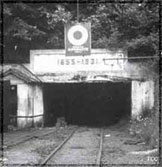
1. 1997- Mine volunteers (first Coal Brought out of the mine since 1972)
2. 1997 - No. 9 Mine tunnel, David Kuchta, John Fauzio (background)
3. No. 9 Wash Shanty Coal Museum
1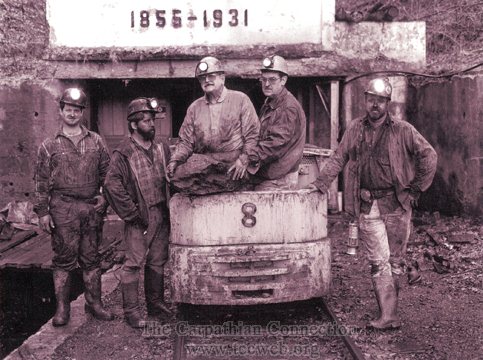
2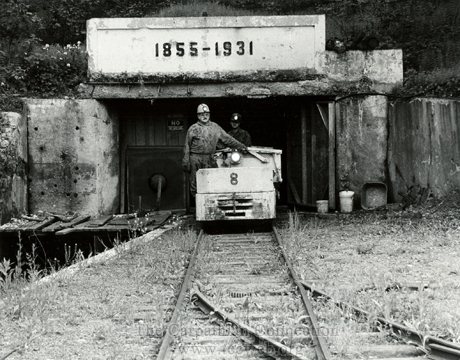
3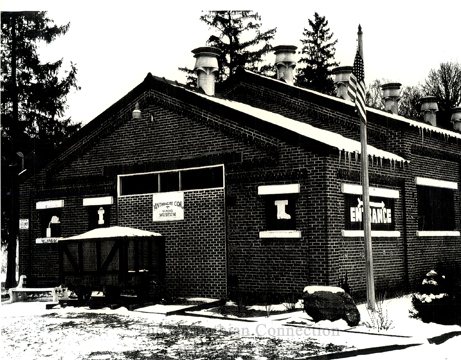
Here in the Panther Valley and most of Carbon and Schuylkill County we have all read and were taught in school that Anthracite Coal was first discovered here in Summit Hill in 1791. That fact is correct as far as Anthracite Coal being discovered in the southern hard coal fields, but Anthracite Coal was already discovered in parts of Lackawanna and Wyoming County here in Pennsylvania. Some over enthusiastic historians have described this event as the first discovery of Anthracite Coal in Pennsylvania, but researchers claim otherwise. Even the very stories about Philip Ginder's life are erroneous. As early as 1826, a Quaker physician by the name of Dr. Thomas C. James read a paper about a brief account of the discovery of Anthracite Coal, before a Historical Society of Pennsylvania, in the city of Philadelphia. Even as he made his speech, he apologized for his problem of forgetfulness, because of aging. It seems from that time on the story that the good Doctor gave was the accepted version. Even Philip Ginder's name was misspelled. That is why all the stories and statues show the name Philip Ginter instead of Ginder.
Yes, Philip Ginder discovered Anthracite in 1791, but it was already discovered in Wyoming County, many, many years before. The earliest reports of anyone knowing about the existence of coal beds in Pennsylvania, was by the Indians, 75 years before the Revolutionary war, according to a William Griffith, Geologist and Mining Engineer from Scranton, Pa. In 1710, Indians knew of the existence of anthracite coal beds in the Wyoming Valley area. On July 11, 1754, Lackawanna and Wyoming Valley coal regions were included in the sale of property by the Five Nations Indian Tribe to the Susquehanna Connecticut Co. The purchase price of the entire property was about $10,000. In 1762, the first Connecticut settlers, after camping at the mouth of Mill Creek, above Wilkes-Barre, and after several days of cutting hay on Jacob's Plains returned to Connecticut and reported the discovery of anthracite coal. In 1763, Indians from that locality visiting the Governor of Pennsylvania and complained of being robbed of a mine by whites. This mine was believed to have been a coal mine.
If you really give this a lot of thought, Indians were the first people who officially mined anthracite coal here in Pennsylvania. Without written reports or proof of this happening, the Indians once again will receive no credit, where credit is due. In a letter from James Tilghman of Philadelphia to the Proprietaries, Thomas and Richard Penn, Spring Garden, London, it is stated that a Colonel Francis had found a very great find of coal at Wyoming, in the hills that surround a very fine and extensive belief. "This coal," says the letter, "is thought to be very fine". With his compliments, Colonel Francis sends you a piece of coal. This bed of coal situates as it is on this side of the river, and may at some future time or other may be a thing of great value. In 1768, Charles Stewart surveyed Sunbury, and on maps indicated the presence of "stone coal" at Ross Hill, now Edwardsville. Around 1750, Anthracite was supposedly discovered in East Central Pennsylvania, but it seems to center around a legend or folklore. It is a known fact that Indians were using stone coal many years before the White Man settled in Pennsylvania. They didn't use it for fuel but for other purposes.
Another story was about some Indians seeking the services of a gunsmith to repair their flintlocks. The gunsmith told the Indians that he had run out of charcoal and couldn't fire up his forge. The Indians supposedly left in a hurry, only to return a few hours later with a bag of what appeared as "black stones." By using a wood fire, the Indians ignited the "black stones," in the blacksmiths forge. The fire was so intense that the blacksmith was able to do his metal repairs. The Indians wouldn't relinquish any information as to the source of this mystifying fuel. Like I said, This story is based on a legend. From what I have researched, I think this story is true. On August 14, 1766, a resident of Wyoming Valley mentions in a letter an abundance of coarse, combustible material, which was, called Anthracite coal. The word Anthracite comes form the Greek word, "Anthrakitis." In 1769, two blacksmiths by the name of Obadiah and Daniel Gore of Wilkes-Barre obtained the location of a deposit of "black stones," from some Indians. In time they learned to use and maintain an on going fire, in their forges. In 1775, coal was being mined on the banks of the Susquehanna River, near Pittston. By 1775, the news of this new heat generating substance spread to other Pennsylvania settlements and finally to the city of Philadelphia.
In 1776, two Durham boats located down the Susquehanna River, came up to the Wyoming Valley for coal. The coal was purchased from R. Geer, who had a mine opening about the mouth of Mill Creek. There are also reports that some Anthracite coal was used to help make arms for the Continental Army, in the governmental arsenal at Carlisle, Pa. in 1775. In the next 30 years, various experiments with the black stone were done but very little attention was achieved. At that time the use of coal was quite limited. In 1788, John Schopf, in a book named "Travels," mentions a visit he made in that year to a bed of brilliant black coal, a mile above Wyoming, which on handling leaves no taint and burns without emitting an offensive odor. Judge Jesse Fell, of Wilkes-Barre, Pa, made nails in 1788, with the use of anthracite. In 1790, coal was known to be plentiful in Schuylkill County, but was not mined because of a lack of demand. In the fall of 1791, Philip Ginder discovered coal on Sharp Mountain near Summit Hill. Although little was known about this black rock that burns, Ginder had heard stories about it. The stories that said, Ginder was a poor trapper and hunter are false. Actually Ginder was a Miller and had built his own gristmill. This is the reason he was in the vicinity of Summit Hill. He was looking for sandstone conglomerate to make milling stones. In the process he came upon the so-called stone coal that he had heard about.
To satisfy his curiosity he took a couple of pieces to his friend, Joe Neyer that lived in the Mahoning Valley. Neyer was a blacksmith and was also inquisitive about this coal stone and threw several lumps on his charcoal fire to see what would happen. At first it didn't burn, but in time it ignited. Ginder's accidental discovery along with a successful experiment in Neyer's black- smith hearth became well known throughout the area. It was also reported that coal was discovered in the area of Room Run, south east of present day Nesquehoning, before Ginder even found the coal on Sharp mountain. This discovery at Room Run led to the future development of that area in Nesquehoning, PA. After Ginder realized you could burn the stone coal, he carried several lumps to Colonel Jacob Weiss. Weiss then took a couple saddlebags of this stone coal to Philadelphia were he offered the find to a few prominent Philadelphians. These men then contacted experts who gave their opinions on the value of the coal as a mineral and its commercial potential. They found that they did have trouble keeping the coal burning, but after some experimenting they realized the value of this new fuel. Colonel Jacob Weiss, along with Michael Hillegas, John Nicholson and Charles Cist, all of Philadelphia eventually purchased 10,000 acres of land were Ginter had first discovered the coal. They then formed the first coal mining enterprise in America, The Lehigh Coal Mining Company in 1792. All this land that was purchased took in the area of where Lansford and the Number 9 mine is located. On February 11, 1808 Judge Jesse Fell made an experiment in the bar room of his hotel at the corner of Washington and Northampton Street and on the flyleaves of a book entitled, "The Free Mason's Monitor,"and made the following memorandum. "February 11th, of Masonry 5808, made the experiments of burning the common stone-coal of the valley on a grate, in a common fire-place in my house, and find it will answer the purpose of fuel, making it a clearer and better fire, and less expense, than burning wood in the common way."
This experiment excited great interest and people came from far and near to watch further experiments, which were made in a grate of iron, and soon there were dozens of similar grates being constructed and put into use. From this point on, the use of anthracite coal took on a whole new prospective as another type of fuel to be used in forges, industry, and in homes. In 1817, an engineer by the name of Isaac Able Chapman was hired by the state to do land mapping of certain regions. Along with his regular work he also marked down various outcrops of coal veins in, which later became, Carbon County. This is the same Chapman who drove the Hackelbernie Tunnel and may have been involved with the down track of the first gravity railroad which later was known as the Switchback Railroad that ran from Mauch Chunk to Summit Hill. Isaac Able Chapman also became the first engineer hired by the Lehigh Coal and Navigation Company.
First Mining in the Southern Coal Fields:
In 1814, Miners, Cist & Robinson made their first shipment of coal to Philadelphia near Mauch Chunk. Two boatloads arrived at Philadelphia and were largely purchase by White & Hazard for $21 per ton and used in the first successful effort to utilize anthracite in the iron industry at their wire mills at the fall of the Schuylkill. In 1815, being firmly convinced of the value of the coal, White, Hazard and Hauto set about securing a lease on the Lehigh Coal Mine Company land near Mauch Chunk, for 10,000 acres for 20 years, for "one ear of corn per year, if demanded." In 1819, a coal quarry, which became known as "The Old Mine," in the Summit Hill area was started. This Quarry was located in the area of the "Mammoth Vein." This large Mammoth bed of coal got to be known as the most important of all Anthracite deposits. In 1822 the Coal Company became incorporated under the name of Lehigh Coal & Navigation Company. As early as 1814, two prominent businessmen or entrepreneurs, by the names of Josiah White and Erskine Hazard were starting to get involved with Anthracite Coal. These men were very interested in promoting and marketing this new fuel. Because of them the building of the Lehigh Canal system came about. Also they were instrumental in building the first gravity railroad and the development of the vast coal lands between Tamaqua and Mauch Chunk. Their accomplishments could fill volumes of reading material.
During 1820, The Lehigh Coal and Navigation Company began mining and shipping coal. The price for a ton of coal at Philadelphia was $8.40. Shipment that year was 365 tons. 1829 opened The Lehigh Canal from Mauch Chunk clear down to Easton. In 1837, Lehigh River navigation to White Haven was opened. In 1831 the Nesquehoning Railroad and plane was built. By 1849, the quarry in Summit Hill had to be abandoned because of flooding waters. At that period of time, they didn't have the high volume water pumps and couldn't remove the water to keep the quarry operable. In view of some coal workings being soon worked out and also the large quarry being flooded, it was decided to drive a tunnel on a level with the bottom of the Panther Creek Valley into the large (mammoth vein) on the south sided of the valley. At this point, we can use the dates of 1844-45 as the time of the No. 9 Mines conception. Around 1845, plans for the No. 9 Mine were on the drawing board. Two attempts to drive the mine, back in 1851 and 1853, were unsuccessful. In 1851 the Company set its goal to drive in around 800 yards to the mammoth vein of coal. On January 14, 1852, a proposal was accepted from Daniel Bertsch to drive the No.9 tunnel, a distance of, "about seven hundred yards."
On March 26th of that year, the contract with Daniel Bertsch for driving the tunnel No.9 was ordered to be executed under Corporate Seal. In that year the tunnel was driven forward 166 lineal yards at a cost of $6,228.74. In the Annual Company Report in 1853 "But little progress has been made in driving forward the No.9 Tunnel, since my last Annual Report. It seems that after driving in about 195 yards, the rock suddenly dipped down below the bottom of the tunnel, leaving a bed of quicksand to contend with. After several attempts to secure it with timber, it was given up as impracticable, without incurring a large and unjustifiable expense. As a final resort, it was concluded to make an open cut, about 150 feet in length and 70 feet in depth, which will require three or four months to complete. There has been expended on this project, $9,807.81." By January 1, 1856, Tunnel No.9 had been driven forward 1119 feet without striking any coal. This project took three or four months to complete this work. In time they also found that part way in the tunnel of this mine there was an area know as a "squeeze area," During the early years this had to be heavily timbered.
During 1855 and 1856, driving in the #9 mine had begun in earnest. The miners had reached the large mammoth vein of coal, on December 25, 1857. The miners had driven 2,283 feet to accomplish their goals. On January 30, 1858, a proposal for mining coal from the No. 9 Tunnel came from Daniel Bertsch for the years 1858 through 1860 for 90,000 tons of coal per year and was accepted by the Company. This led to the first mining contract for this particular tunnel. On March 31, 1858, the mining contract with Daniel Bertsch was ordered to be executed under Corporate Seal. This mine was finally closed down to mining in 1972. At that time it was the oldest continually operated mine in the world. Hopefully in late summer of 1999, it will be open to tourists.
by, David Kuchta
Article is researched from a reprint of Joseph Henry Zerbey, History of Pottsville and Schuylkill County and from the Republican Paper, March 1-12, 1934.
The beginning of Coaldale (Coal Dale) dates back to the year 1827, when John Moser and his wife settled there. Moser was born on May 24, 1805, in Tamaqua and was the son of Mr. and Mrs. Burkart Moser, the original settlers of Tamaqua. Upon arriving at Coaldale, John Moser built a log cabin on the north side of what was known as the Manila Grove Park. At present, the Coaldale Hospital is located on this very site. After building the cabin, Moser cleared the land for the purpose of raising products for his own use. His principal occupation was hauling coal and timber to Tamaqua. This he continued until about 1887 when he vacated his farm due to the fact that a coal company possessed his land and began the building of a breaker for the purpose of preparing coal. This breaker was known as the Number 12 and was owned by the Lehigh Navigation & Coal Co. He made his next home with his grandson John Barrett and during his stay with his grandson he went into the dairy business.
In the year 1888, he was appointed as the first tax collector of Rahn Township, Coaldale at that time being a part of the township. At that time it was the duty of the tax collector to go to the homes of the taxpayers to collect the taxes. Along with his dairy he kept this tax collector position until his death in 1895. He was interred in St. John's Lutheran Cemetery in Tamaqua, which was the first cemetery in the vicinity and is now know as Dutch Hill. John Moser had four daughters; and holds the distinction of being the father of the first white child born in Coaldale. Before becoming a borough, Coaldale belonged to Rahn Township. At that time it included the area of Coal Dale, Owl Creek, Number Eleven, and Seek.. In 1906, the prominent men of Coaldale held a meeting for the purpose of organizing a borough. The borough was organized in June of 1906, and Dr. C. C. Gallagher was elected the first Chief Burgess. Rahn Township at that time was almost exclusively coal lands although some attempts had been made at farming in the Owl Creek Valley. This township was greatly reduced in size, population and importance by the incorporation of the Borough of Coaldale.
Rahn Township included Coaldale, Tamaqua and Seek Villages. Coal was mined in this township as early as 1858, but up to 1860 the output was small. Chas. F. Shoener and Wm. Carter purchased the Greenwood Breaker property and commenced extensive developments. Mr. Shoner soon bought his partner's interest and invested a million dollars in perfecting the improvements, which subsequently became very valuable. During the first year the property yielded an income of $50,000 a month. It was then sold. The breaker was burned in 1874 and in 1878 the Lehigh Navigation and Coal Co. purchased this property. The villages formerly in Rahn Township were; Bull Run, which is now included in Coaldale as one of its streets and Gearytown, which is now Miner St. and Greenwood St. Centerville was located on the south side of Coaldale but had been abandoned because it was under mined. Most of all the buildings of the mining villages were principally frame. The first houses were erected during 1864 in what was known as Bugtown, which is located along the main highway directly below the Coaldale State Hospital. Two years later, houses were built at old Coaldale, which was located on the eastern part, now the eastward.
New Coaldale, which is now the middle ward, was begun in about 1849. New Coaldale or New Wales began to attract attention in 1868 and buildings were erected on the line between Schuylkill and Carbon Counties in 1870. Gearytown was named in honor of Governor John W. Geary. Its first dwelling was erected in 1866 and was occupied by Richard Boyd. The village of Coaldale had a population of 1,849 in 1890. Before the advent of the railroads, stagecoaches were the principal means of transportation. On these coaches they transported food as well as passengers. A stagecoach ran through town twice daily, and the fee for people riding on this coach was fifty cents from Coaldale to Tamaqua. After the stagecoach went out of existence, the streetcar came into use. In the fall of 1897 the road opened from Lansford to Mauch Chunk, and later it extended from Lansford to Tamaqua then to Middleport. The first dirt road that passed through Coaldale was built between the years of 1815 to 1819. This road started at Dutch Hill (Tamaqua) and came east along the side of the mountain at No.10 Colliery and passed through what is now the No. 10 Culm Bank. It then turned south and branched out, one part going up through No. 11 and it passed by the mouth of the tunnel and then went up over the mountain into Owl Creek.
Another road also led from what is now Second St. in Coaldale, formerly called Thompson Street, continued south to its connection with the Tamaqua-Summit Hill stage coach road and continued over the mountain into Owl Creek Valley. Another trail, which was used to a great extent is still in existence (1934). It started from the old Moser's Farm, situated at the base of the Broad Mountain directly north of what is now Railroad St. and continued to the No.12 and over the Mountain into Greenwood. The first railroads built through Coaldale were those for the accommodation of the coal trade. The cars were drawn by horses, usually in a forty-inch gauge track. The rails were made of four by six-inch rod timber. The ties were notched to receive the rails. The notches were 2 inches wider than the rail and wooden keys were used to maintain the proper gauge and prevent the rails from spreading. There was a flat iron bar from one half inch to two and a half inches wide on top of the rail to obviate the wearing of the wood by the friction of the car wheels and contribute to the ease of draft. Lateral roads of this character were established at an early date to connect the mine with those which conveyed the coal to the canal. They continued to the year 1934 as auxiliaries to the steam railroads.
The route of this railroad that first ran through Coaldale started at Spring Tunnel. From Spring Tunnel it continued to the east of Centerville.(Skin Town) It then ran into Carbon County to a small village called Sayersville. (No. 3 Area or No. 9 Mine Shaft) From this point it continued northward into what is now called No. 7. (Lansford) There was also a railroad, which carried coal from one of the premier mines called Foster's Tunnel. This railroad started from Foster's Tunnel, continued up Kline's plane, which is now called the first plane, and met the first railroad at Spring Tunnel. The Nesquehoning Railroad was chartered April 12, 1861. The line was built from Carbon County through Coaldale to Tamaqua and radiated to coal lands in the vicinity. It was leased and operated the Lehigh Coal Co. who subsequently leased it to the Central Railroad Company of New Jersey.
Youth & the Coal Mines
by, David Kuchta
In the years between 1850 to the 1890's, life in the hard and soft coal mines was very hard and indeed dangerous. To some who worked in the mines life was indeed short. Regardless of age or what ethnic group one belonged to, death was always a present specter for deep coal miners. Over the years, over 31,000 workers were killed while working in or around the mines. There were hundred of thousands of injuries along with the deaths. When the early Slavs (Slovaks as well as Rusyns) came to work in the mines, it wasn't all that uncommon to have the Coal Collieries employing children as young as 12 years of age. At times, they even hired children as young as seven.
These young workers were so small that their lunch cans dragged on the ground as they walked to work. In the early years of mining, there were not any age restrictions. In later years, (early 1900's) any worker that was hired had to be 14 years of age. Recently, while doing some research on my up and coming book regarding the No. 9 Mine, I ran across an article written about the death of a young mine laborer. Most of the time, when young slate pickers, laborers, or mine door tenders were killed, the mine inspectors left the age blank. I had previously seen the ages of 11 and 12 mentioned in the early mine reports, but, nothing less than that. For some reason or other, the mine inspector put in the age of young Edward Cannon. Even in the write-up of the fatality, they would usually refer to anyone younger than 12 years of age as "the boy."
Following is the report in its entirety:
Case No. 234. Edward Cannon, Irish laborer, aged seven years, was fatally injured by mine cars in the No. 5 mine of Landsford on the 26th day of November, 1884.
This young man was engaged in driving cars, which meant driving mules, this day and while taking out a trip of loaded mine cars, slipped and fell under the cars and had his leg and hand badly crushed and from these injuries later died. The mine inspector must have been so touched by what happened that instead of calling him a boy, he used the words, " young man." Young Cannon's life was very short, for he seems to have graduated from a boy to man in seven short years. During the years between 1860 and the late 1890's, many young workers, many not even teenagers, met their deaths in the mine. Somehow, I feel such despondent sadness come over me when I read the reports of these young mine workers dying at such an early age.
These workers died eons of years ago, and their legacy to life is nothing more then a short paragraph in a mine report on how they died, and a brief epithet on their grave stones (if the family could afford one). These young workers felt so proud, to go to work in a mine or breaker, and to assist the family with the extra income. I would imagine that the child's mother cringed at the very thought of her baby going to work in the mines. Most young workers died because they were too young to know what to do, or how to do it. They had no fear. Most died because they broke the rules, were careless, just didn't understand the dangers that were entailed on the job. Numerous deaths just should not have happened. Life, precious and sacred as we know it is considered brief as it is. For too many of the young miners, life was never permitted the opportunity to start.
Underground Mine Fires
by, David Kuchta
The oldest known continuously burning underground mine fire is in New South Wales, Australia. They think the fire started when lightning struck an outcrop of coal near the surface of the ground. This fire has been burning for over 2,000 years. The Anthracite Coal Regions of Pennsylvania also had its share of mine fires down through the years. At the present time, under the town of Centralia, Pa. is an on-going fire that has forced the evacuation of the town. There are still a few residents who do not want to accept the government buyout. When the final residents are gone from the area, the whole area will be strip-mined and this will bring an end to this famous fire. Because of the vast amounts of coal underground there, any venture in mining in the area will prove very profitable for any contractor getting the job. They claim that there is at least 40 million tons of coal under the town of Centralia.
During the 1800s it was commonplace to build a coal breaker right on top of the vertical shaft where they brought out the cars of coal. These early breakers were made mostly from wood and when they caught fire, the fires ignited the timbers that made up the shaft area, and the fires then entered into the mine areas. Because of the Avondale Fire in 1869, 179 men lost their lives. The government at that time made it a law that coal companies couldn't build the coal breakers on top of mine shafts and also all coal mines had to have second openings or escape ways. Also in the late 1700s and early 1800s, a furnace to supply heat for ventilating the mines and shafts was used. These furnaces were located on the bottom of the vertical shafts. This type of furnace was responsible for igniting coal gases that came into the area. Over a period of time, many different types of ventilating systems were used and eventually large fans driven by electric motors were placed on the surface of the ground above air shafts that helped ventilate the mine areas.
Here in the Panther Valley area of Pennsylvania, up in the Summit Hill area, a mine fire that became know as the "The Burning Mines," became a famous tourist attraction. At night, the view of the fire that broke through the surface was awesome. Tourists came from all over the world to ride the famous Switchback Railroad and then view, "The Burning Mines." In time the Lehigh Coal & Navigational Coal Co. dug a huge trench across the Mammoth Vein of coal that was burning and placed a concrete and clay barrier to stop the fire. This helped somewhat but other measures of underground dams and water eventually had to be used. In the early days, many people dumped trash and other debris down the old fall-ins or stripping pits. In time someone would torch the trash and some of these fires eventually reached the coal seams that were located at the bottom of the pits. Also lightning would hit old dead trees and if the trees were located above an outcrop of coal these coal veins would get ignited. If the fire was accessible to the collieries, the Coal Company would lay out wooden pipes to the area and spray the area continually to put out the fire. If the fire went too deep under the surface, or caught some of the coal mine workings on fire they built concrete block wall seals, across the tunnels or gangways (isolating the area) and then flooded the area with huge amounts of water to put out the fire.
Sometimes this flooding of the mine took from six months to years to extinguish the mine fire. These fires became so hot that the top and bottom rock on either side of the vein of coal would get red-hot. Because of this, even when the coal fire was extinguished, steam would form for long periods of time. Strange as it seems, steam permeated out of the surface of the ground for years after the fire was officially out. Just south of the Panther Valley High School was such an area. When they were talking about building the school there, I mentioned this potential fire. When the smoke/steam was checked there was no carbon monoxide. The mine inspectors said it was nothing more then steam. When the mine officials were satisfied that any mine fire was out, water would be pumped out of the section of the mine that was flooded. Then the seal barriers were removed and if the engineers or state mine inspectors gave their final approval, mining was once again started in the area. The miners working in the area that originally was burning found out that not all areas were completely distinguished. Many times, when the miners made a cut, hot ash would come down their chutes. Also those areas they mined stayed very hot.
As long as the mines operated, underground mine fires were held to a minimum. Once underground mining shut down, then any inaccessible mine fire starting underground was left to burn. If the veins of coal were pinched or if the fire reached areas that were mined out, especially if the pillars were robbed the fires ran out of fuel and stopped burning. When the mines quit operating, the mine pool water flooded most of the lower levels of the mines so that any fire that worked its way downward would hit this water and stop burning. Of course anything above a water level would burn for long periods of time. If the mine fire was near the surface, and located close to any towns then the smoke and stench form these fires were horrible. Of course there was always the poisonous gases that were formed from the fires, which became health hazards. At the East End of Lansford, such a problem existed back in the late 40s and early 50s. The old culm banks caught fire and when there was an east wind the small community of Andrewsville and the East End of Lansford would smell the horrible stench. This also happened at the south end of the community of Tamaqua. They also had an old culm bank catch fire and eventually the Coal Company gave out a contract to have the fire distinguished. Once these fumes cause a health problem to people and there is a public outcry to the fire problem, then action is taken, if possible. Otherwise, most of the coal companies just let them burn. There is a large fund (billions) that is set aside for mine subsidence and mine fires. If there is a threat to homes or roads it is used, otherwise the fire site is just monitored every so often by State Officials.
We would like to express our thanks and appreciation to Stephen Miller for providing us with the following information on the Cook's Run Mine Disaster of 1888.
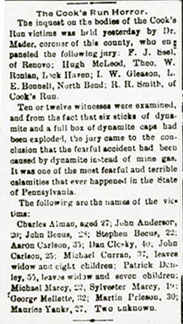
From Lock Haven Express, Lock Haven, PA., Thursday, November 8, 1888 –
GREAT MINE HORROR
Cook's Run, this County, the Scene of the Explosion
SEVENTEEN PERSONS KILLED
Only a Few of the Unfortunate Men Escaped Death
THE CAUSE OF THE DISASTER
The Mangled Victims - A Terrible Scene - Five Injured - Coroner Mader Leaves for Cook's Run
Particulars of the Accident
The Williamsport Gazette and Bulletin on Monday contained the full particulars of the terrible accident at Cook's Run, this county, on Saturday afternoon, and we adopt them as being as complete as anything that can be given. That paper says:
A telegram was received in this city at 6 o'clock Saturday night stating that a terrible disaster had occurred at Cook's Run, Clinton county, in the mine of the Kettle Creek Coal and Mining Company. The dispatch, which was from Superintendent George L. Miller to J. C. Russel, stated that the explosion occurred in the new drift, and that a number of men had been killed. Later dispatches brought to light the fact that the explosion had been accompanied by a frightful loss of life, no less than fifteen men having been killed outright, and several others seriously injured.
The Full Particulars
The accident occurred about 4 o'clock in the afternoon, when a dull, rumbling report was heard. Superintendent Miller hurried to the scene, and upon arriving at No. 2 mine found that the explosion had occurred there. Prompt assistance was summoned, and air was immediately forced to the face of the works. As soon as practicable men entered the mine, and feeling their way along the grimy passageways into the drift, met a terrible scene. Dead bodies were lying around convulsed and distorted by their dying agonies. The scene was a terrible one to gaze upon. The corpses were lying around in every direction. Te rescuers gave immediate attention to the wounded, who were writhing in their torture. The search revealed six injured, one of whom died soon after being removed, and it is feared that one or two more will die. In an hour fourteen dead bodies had been recovered.
Samuel Killinger, Patrick Donnelly, Michael Curran and J. Carlson were the only English speaking men among the killed, the others being Italians and Hungarians.
Bodies of the Dead
Prompt attention to the injured was given, Dr. Weymouth, of Renovo, and Dr. Brennan, the mine physician, doing all in their power to relieve their sufferings. Undertaker Beck took charge of the bodies, and prepared them for burial. Two or three who were in the mine escaped miraculously.
J. Farrel, a driver, was entering the drift at the time of the explosion. He was thrown violently towards the mouth, but strange to say was not hurt. The mule that he was driving was killed. The force of the explosion may be imagined when it is stated that several of the bodies were blown clear out of the drift.
Theory of the Explosion
The general theory is that in making a blast a gas feeder was struck, filling the space with gas, which, coming in contact with a naked lamp caused the explosion. It was one of those things which no one could foresee, and no blame is attached to any one. By a gas feeder is meant a pocket of gas imbedded in the coal, which as soon as a pick is struck into it, escapes and explodes.
The mine inspector was immediately telegraphed to, and was expected to arrive on the first train. The Coroner of Clinton county was also summoned to hold an inquest. The general talk among the miners is to the effect that the ventilation was good, and the mines were well supplied with air appliances.
The Company
The general offices of the Kettle Creek Company are located in Williamsport. Captain David Bly being the President. The mines have been operated since last spring, the coal mined being bituminous.
Information received yesterday was to the effect that seventeen men in all were dead. All arrangements had been perfected for the funerals of the victims which will take place to-day.
Another Theory
A special says that among the rumors is one that the explosion was caused by the inexperienced use of dynamite, a hundred sticks of which were purchased by an Italian, but who was unable to get a fuse, and it is supposed he tried to set it off in some other way. Wesley Smoke and John and Aaron Anderson were badly injured but will recover."
Coroner Mader, of this city, went up to the scene of the disaster Monday and the mine inspector was also looked for. A surveying party Sunday found the body of a naked man fifty feet from the air hole.
Further Particulars
Our Renovo correspondent sent us the following additional particulars Monday:
There are fourteen men laid out, all lying close together, in the blacksmith shop at the mines, and two are with their families. They are burned so bad that they are beyond recognition. Undertaker Beck went up with sixteen coffins last night which nearly filled the baggage car.
There were no less than two hundred people at the mines yesterday and a number went up on the mail this morning. An inquest is being held this morning. Three will be buried at North Bend to-morrow afternoon and eight at Drury's Run. I got the report from the superintendent of the mines. It is impossible to get the names. There were Swedes, Hungarians, and Irish. One man was shot seventy-five feet up through the shaft and there were clothes out on the trees on the top of the mountain. The owners of the mines went up on the mail this morning.
The Renova Record - Thursday, November 8, 1888:
The Cook's Run Mine Disaster
17 KILLED AND ONE DIES FROM HIS INJURIES
The disaster which took place, near Cook's Run, this county, on the Kettle Coal and Mining company's mines, last Saturday afternoon, has already been detailed so minutely in the daily press that we will but add the result of the Coroner's Jury.
The Dead and Injured
Michael Curran, age 37 years. He leaves a wife and seven children.
Patrick Donley, age 55 years. He leaves a wife and seven children.
Chas. Alman, aged 25.
John Carlson, aged 25.
John Anderson, aged 20.
Martin Pierson, aged 20.
Aaron Carlson, aged 35.
John Beckus, aged 28.
George Beckus, aged 32.
Michael Marcy, aged 22.
Sylvester Marcy, aged 19.
Dom Closkey, aged 40.
George Mellets aged 35.
Maurice Yanks, aged 27.
One unknown, aged 24.
The injured are Wesley Smoke. Aaron Anderson and John Anderson, all of whom, though badly cut and bruised, are likely to recover. Many of the dead were terribly disfigured and mangled.
The Cause of the Explosion
The testimony at the inquest all went to show that the mine was properly ventilated and that no blame belongs to any one except the miners themselves. Their familiarity with the dangerous explosives which they used in their daily vocations, had no doubt rendered them careless in the manner of handling it and led to the disaster, which resulted in their deaths. The force of the explosion must have been terrible, as every particle of clothing was stripped from many of the dead bodies.
Holding the Inquest
Coroner Mader empanelled as a jury Messrs. Hugh McLeod and Theodore Runion of Lock Haven, Jos. Seel of Renovo, Mr. Gleason and Mr. Bunnell of North Bend, and James Smith of Westport. The testimony of a number of witnesses was heard and a verdict was rendered. The Coroner stated that the testimony went to show that the explosion was caused by dynamite. The miners were were known to have had a considerable quantity of dynamite in the mines, and shortly before the explosion occurred one of the men called at the supply store and obtained a quantity of fuse with which he returned to the mine. The Coroner states that the testimony of the man from whom the fuse was obtained , was to the effect that the explosion occurred within fifteen minutes after. There was a double explosion, owing to the fact that the powder used by the miners was kept in different places.
Anson Smoke, one of the injured miners, died yesterday, which makes 18 victims from the sad disaster.
The bodies of three Swedish miners who have relatives living in town, were taken to North Bend on Tuesday, and interred in the cemetery of that place. Eight of the victims were buried in Drury's Run cemetery; one was taken to Snow Shoe in Centre county.
Courtesy of David Kuchta
1. A Mine Mule being shoed
2. Breaker Boys
3. Breaker Boys (Slate Pickers)
4. 1887 #9 Mine Tunnel
5. Miners entering Spring Tunnel 1905
1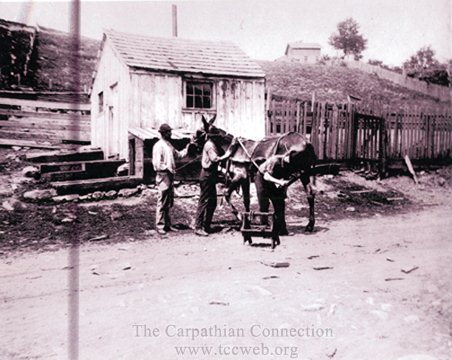
2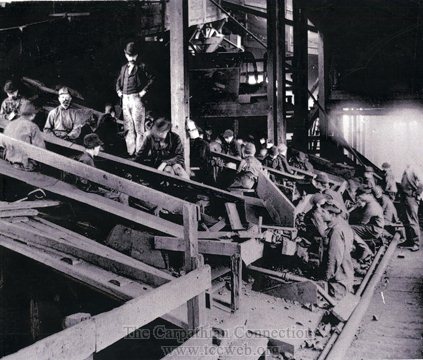
3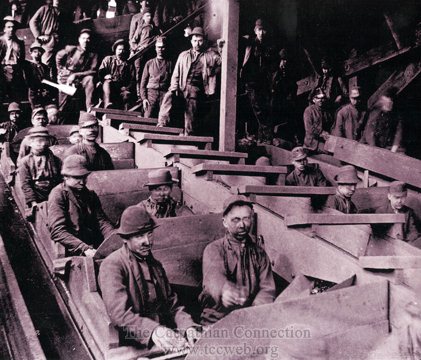
4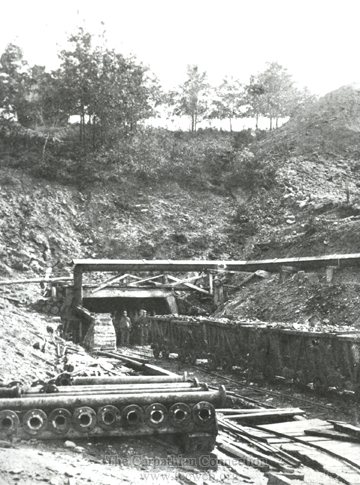
5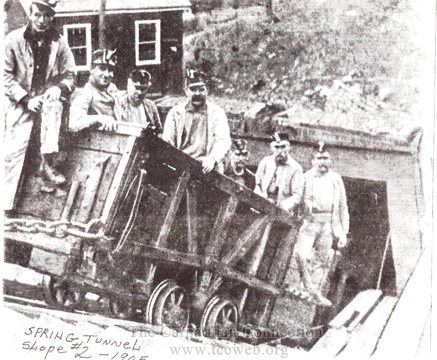
|
|



